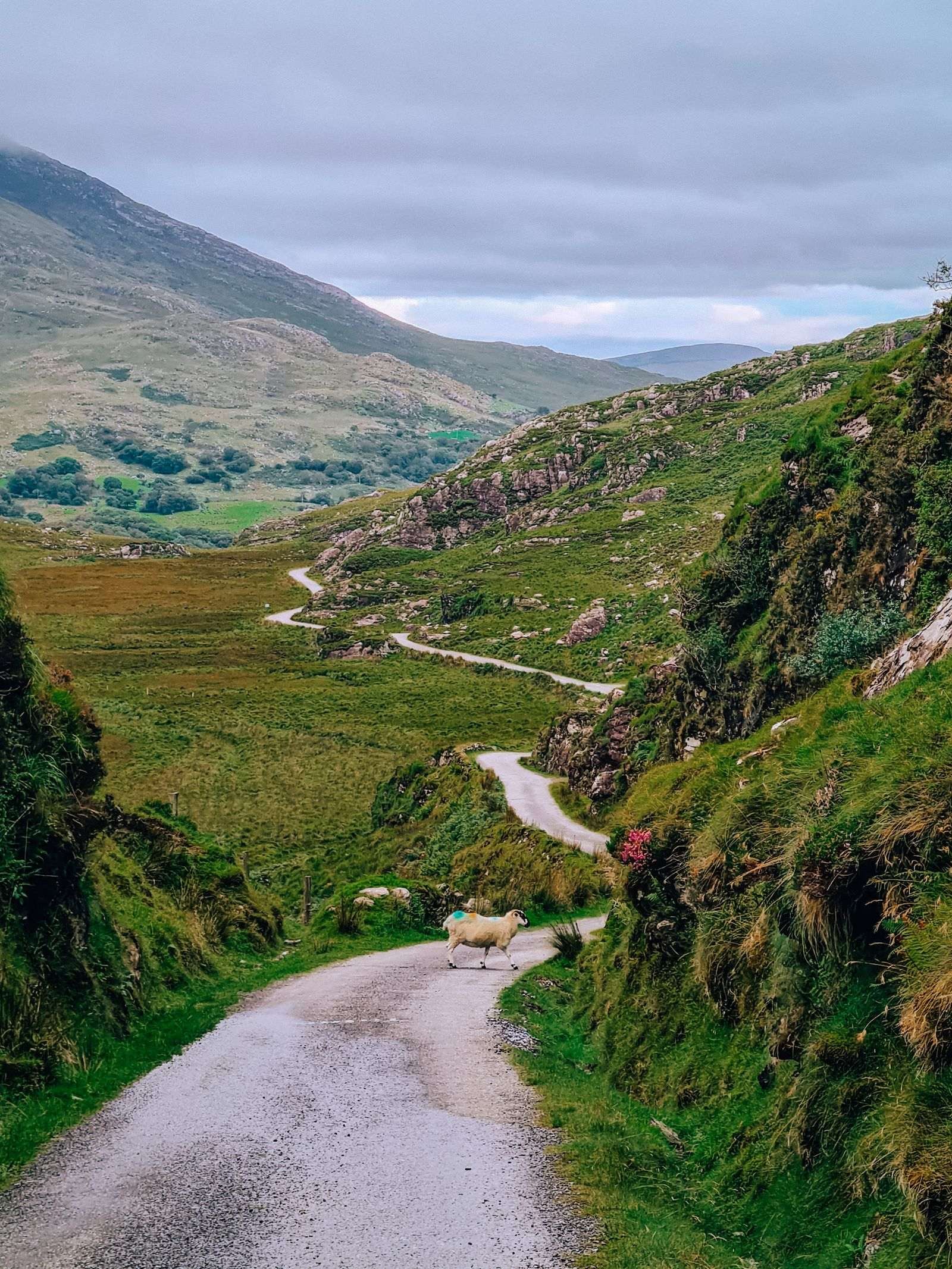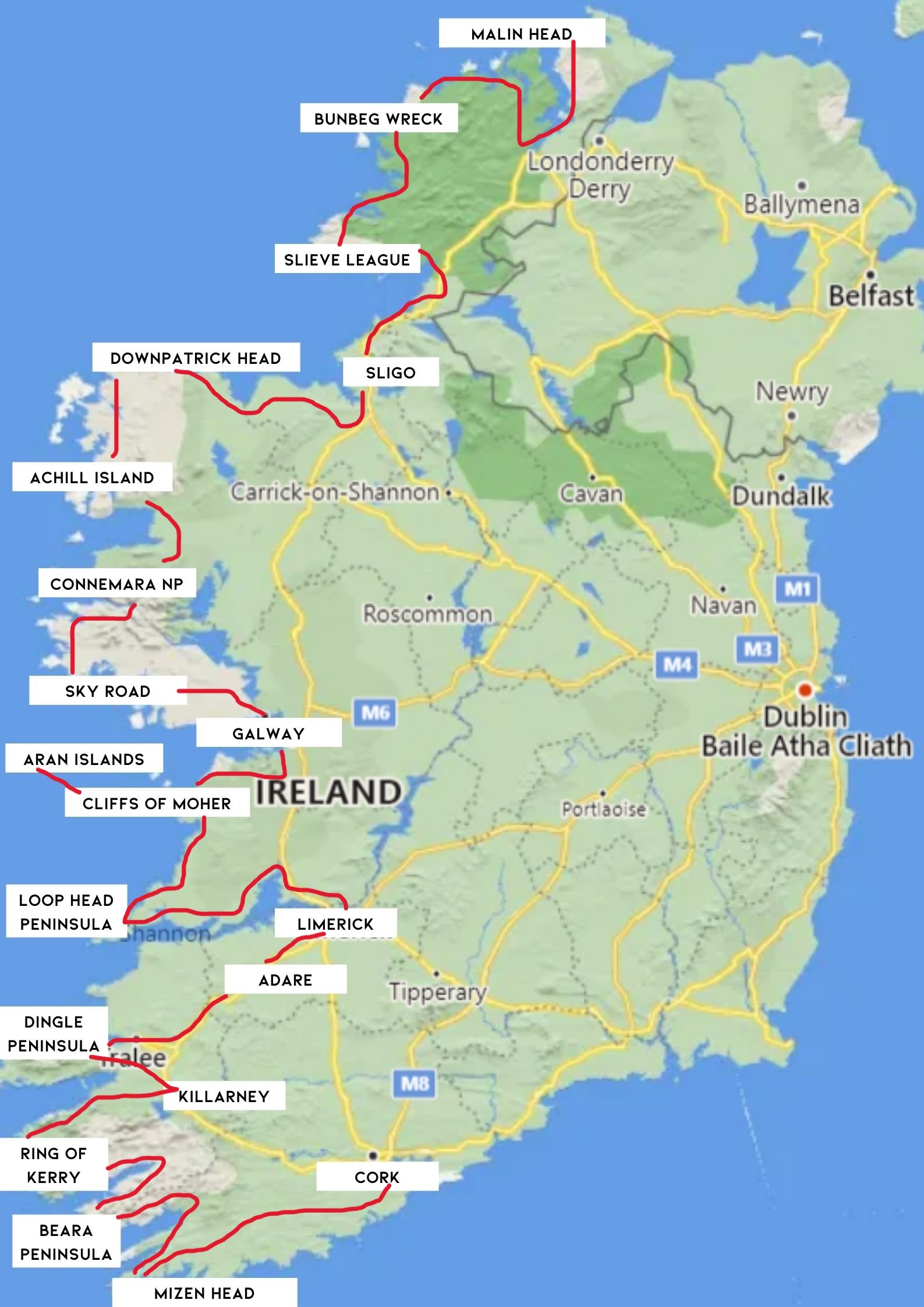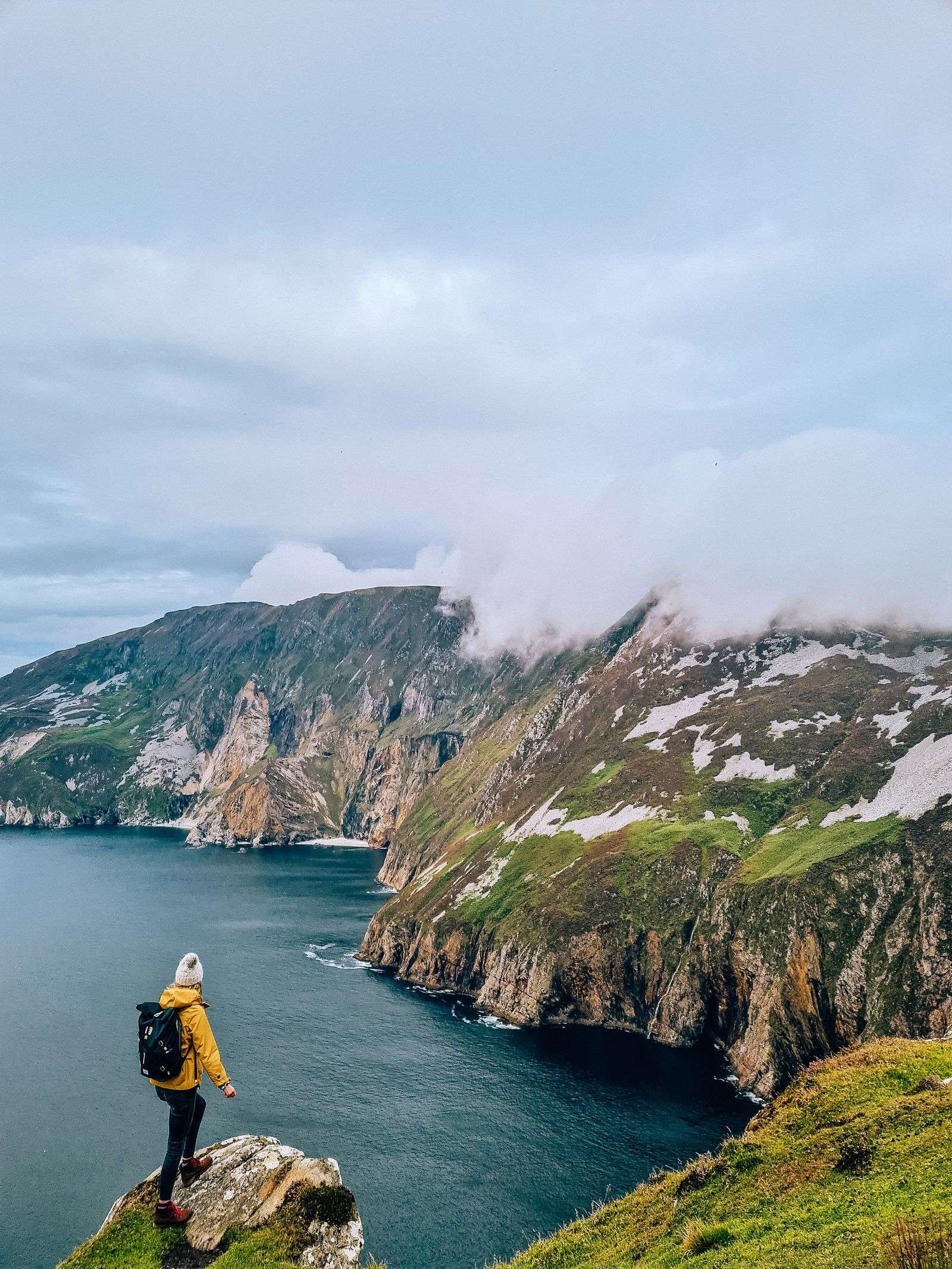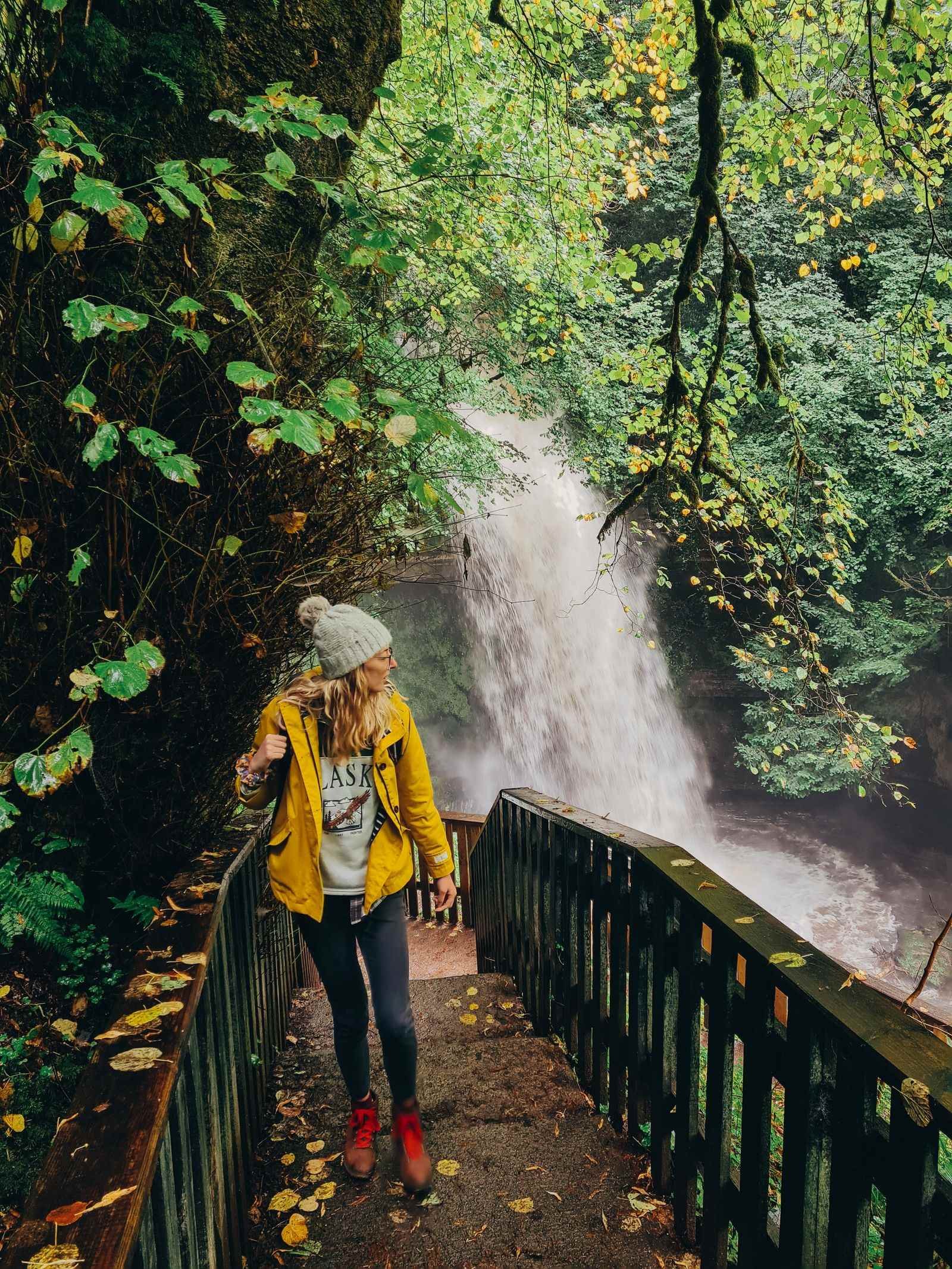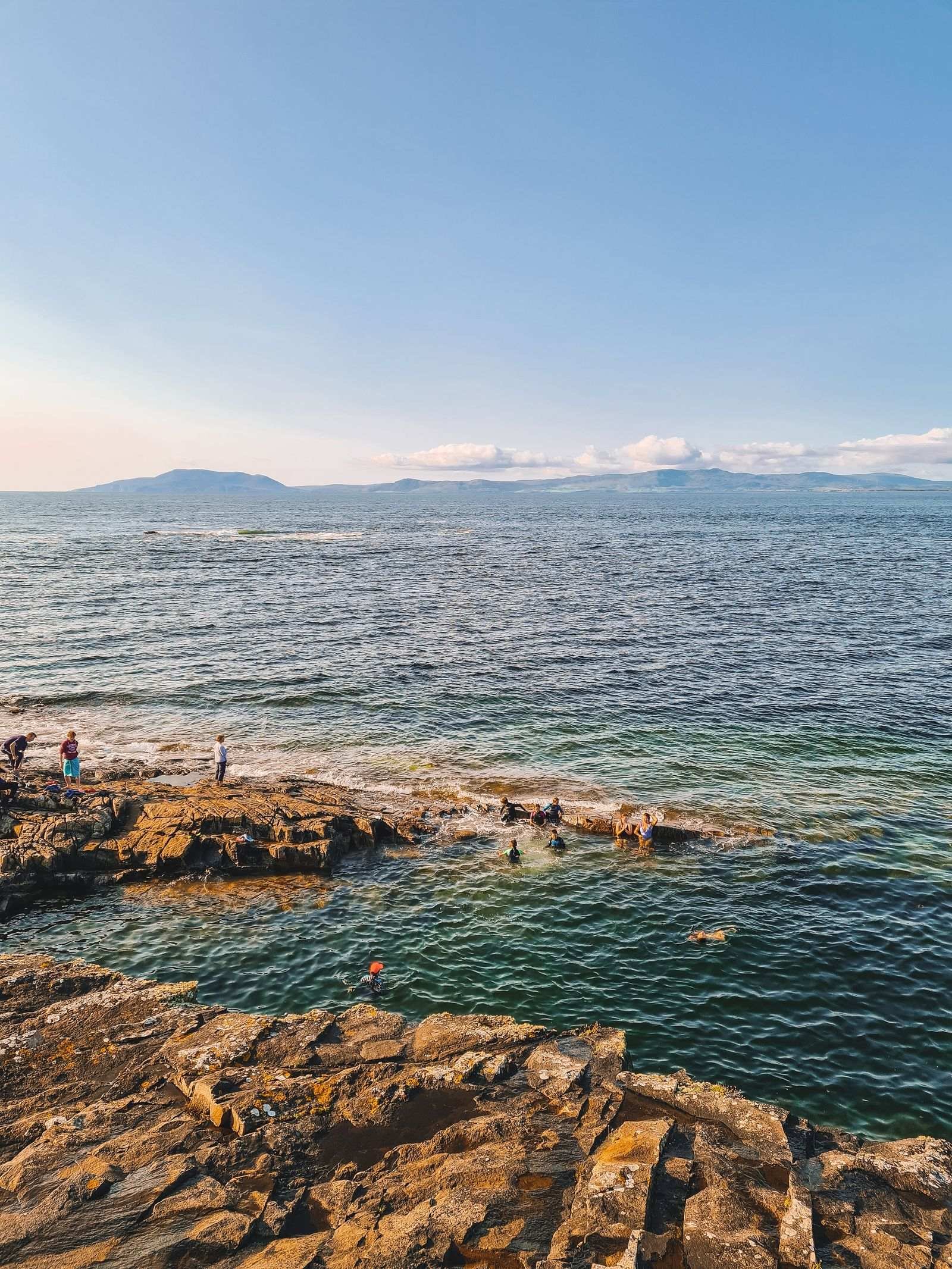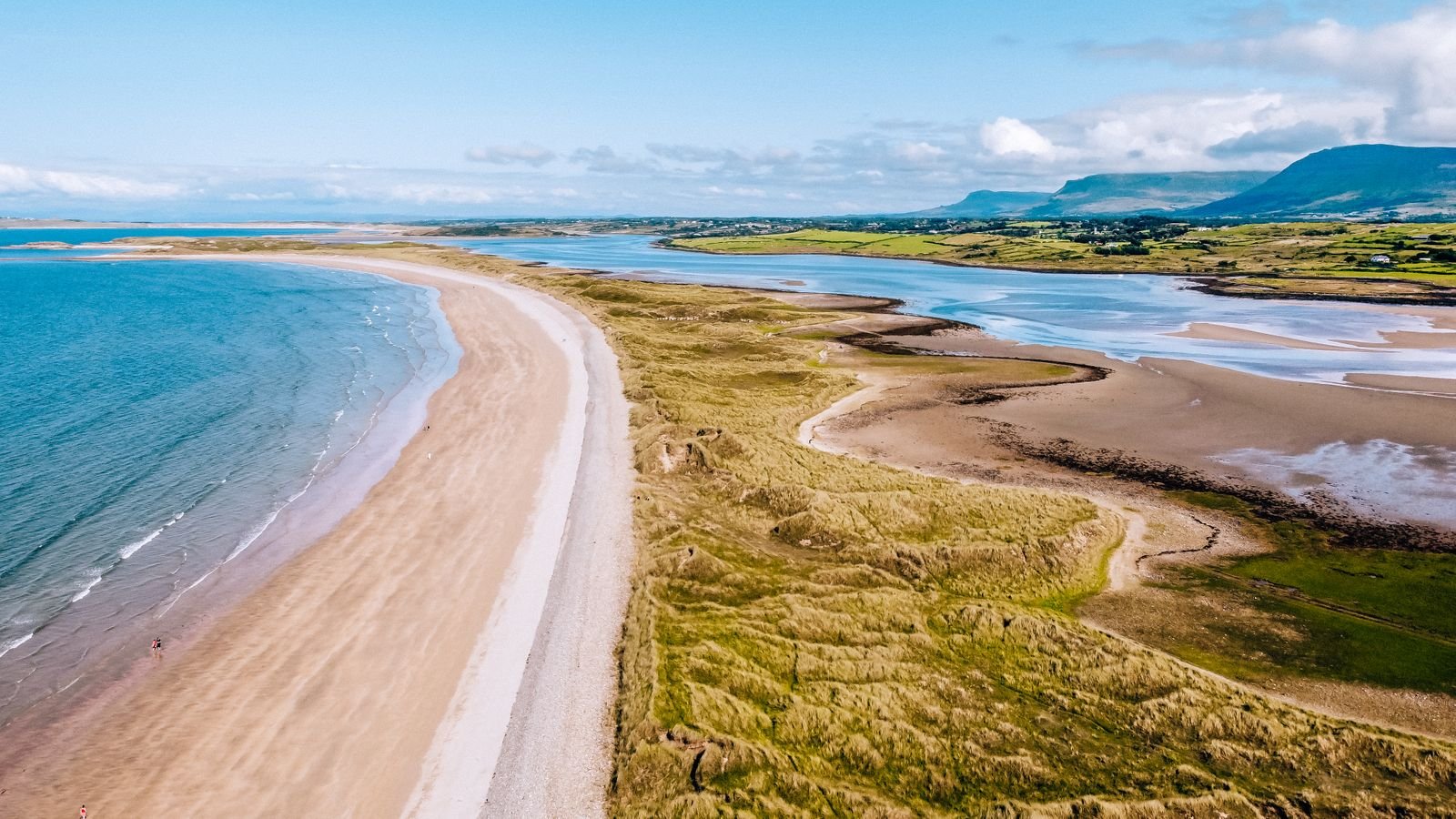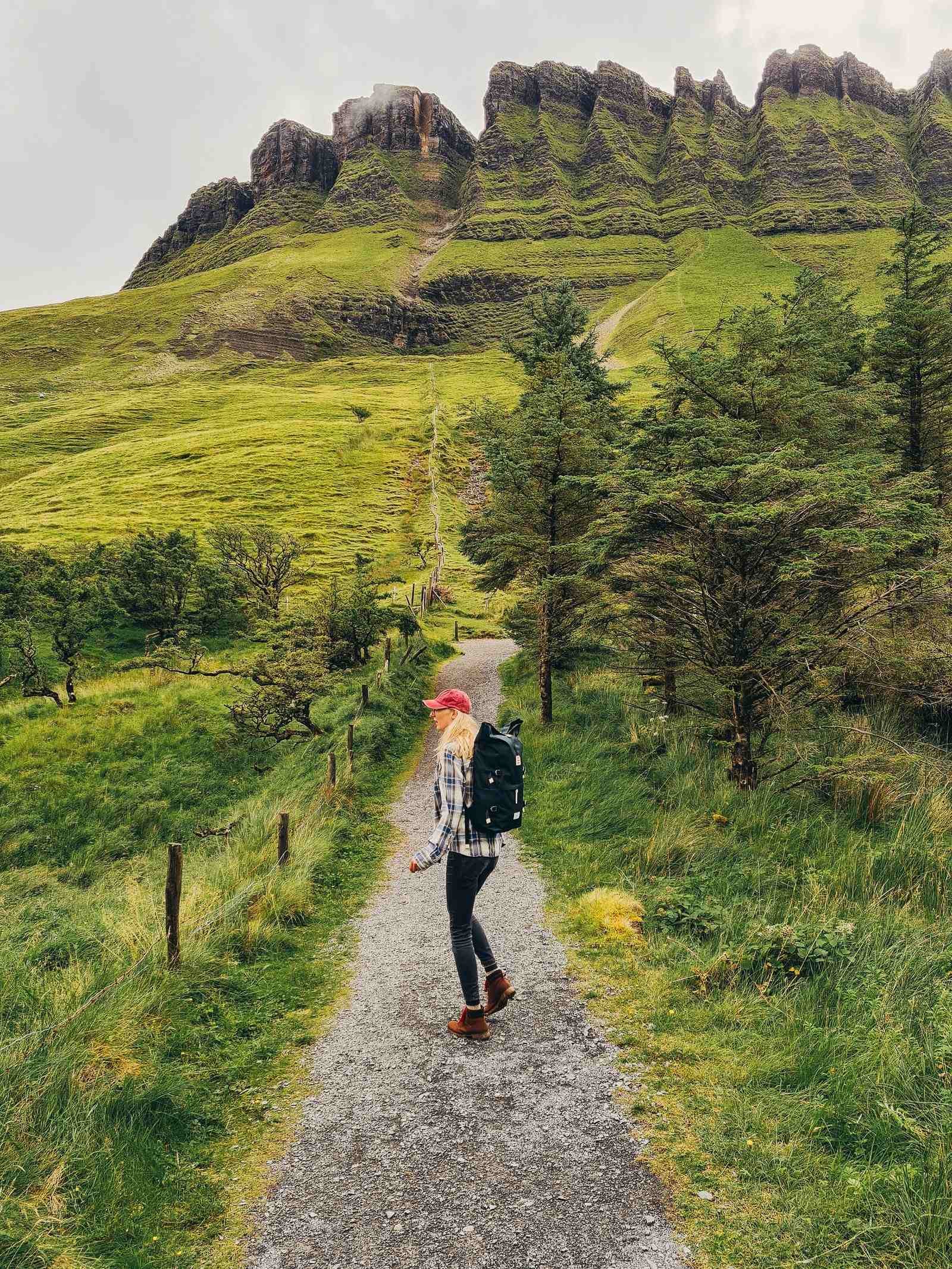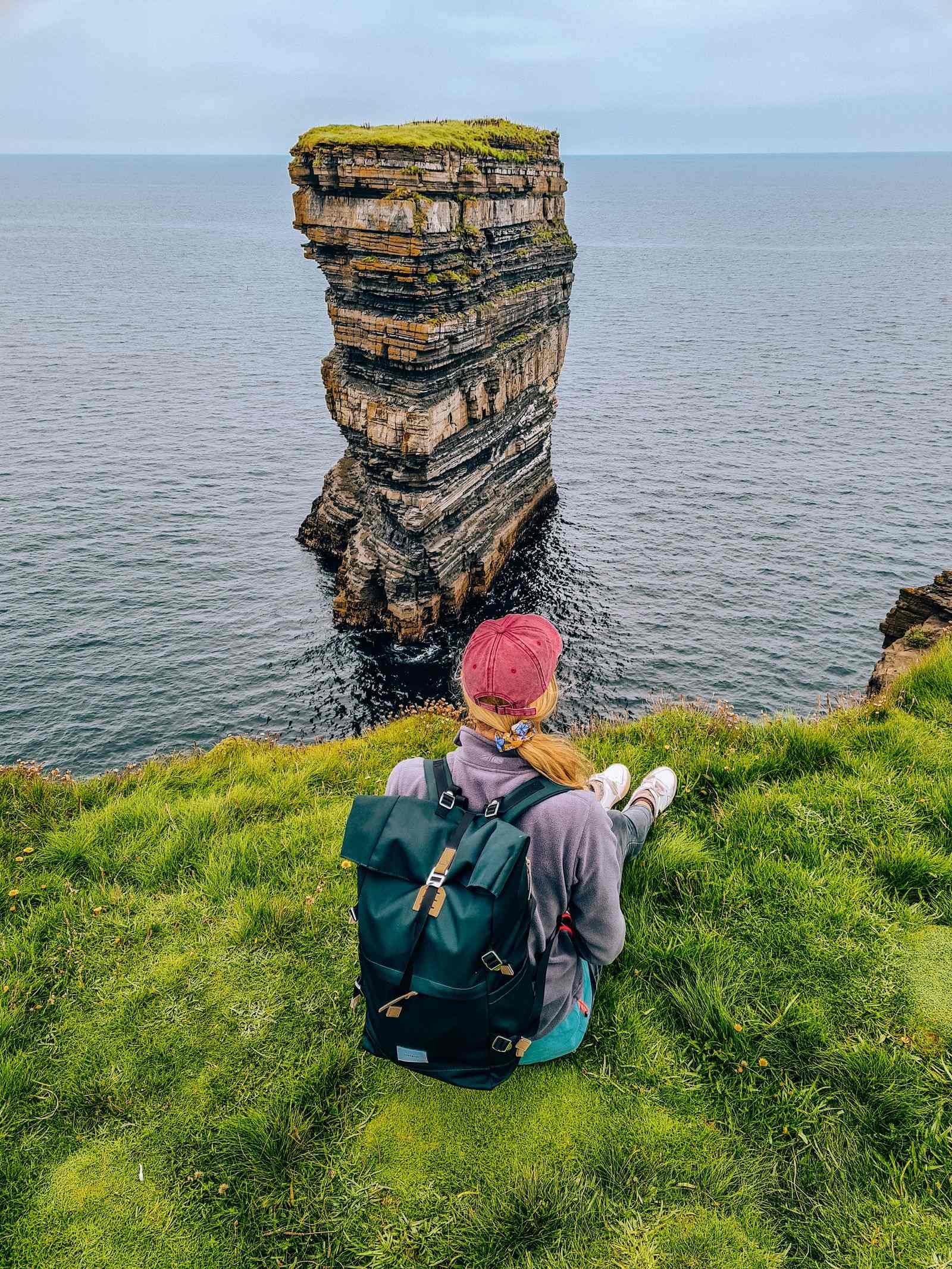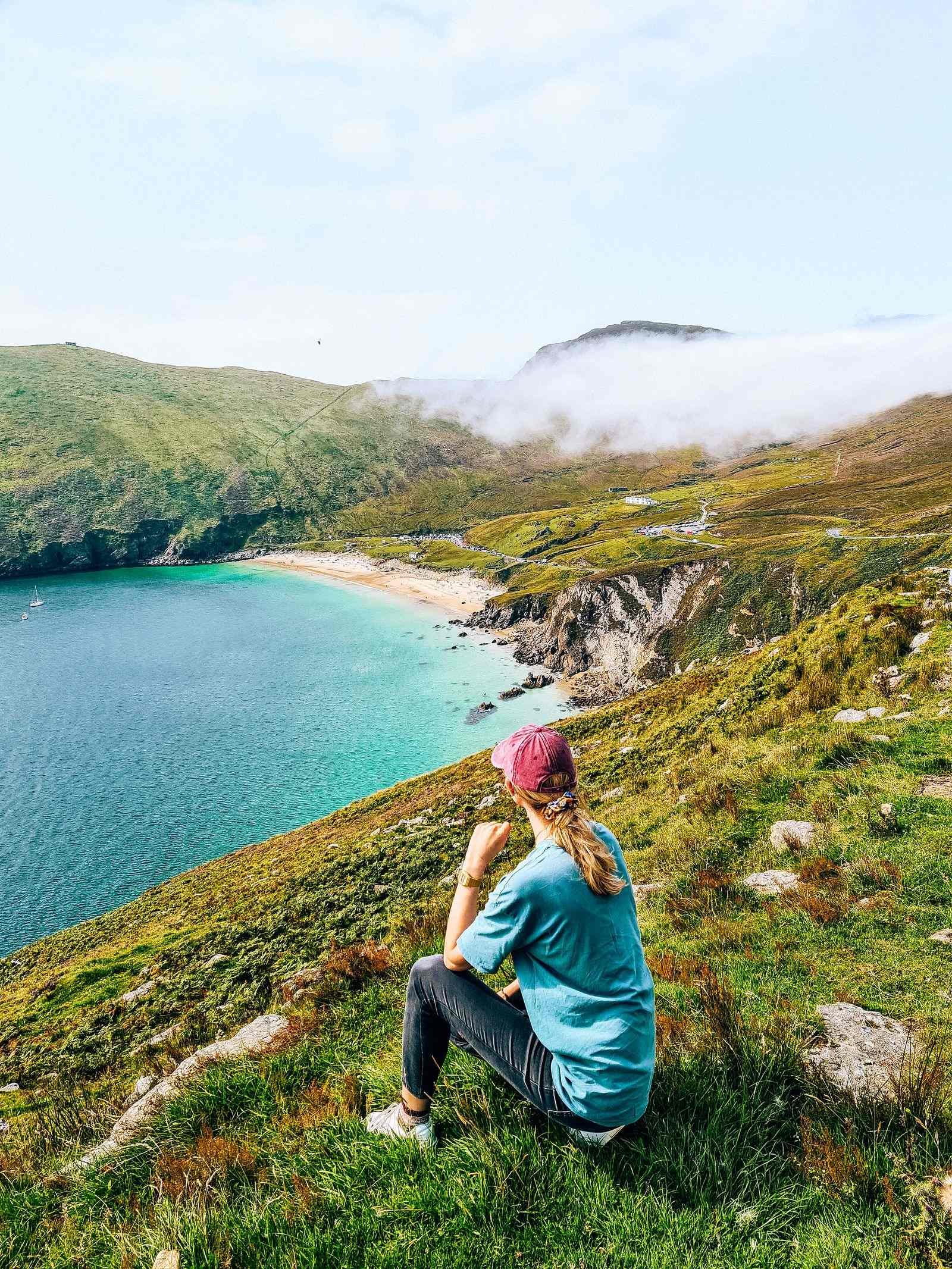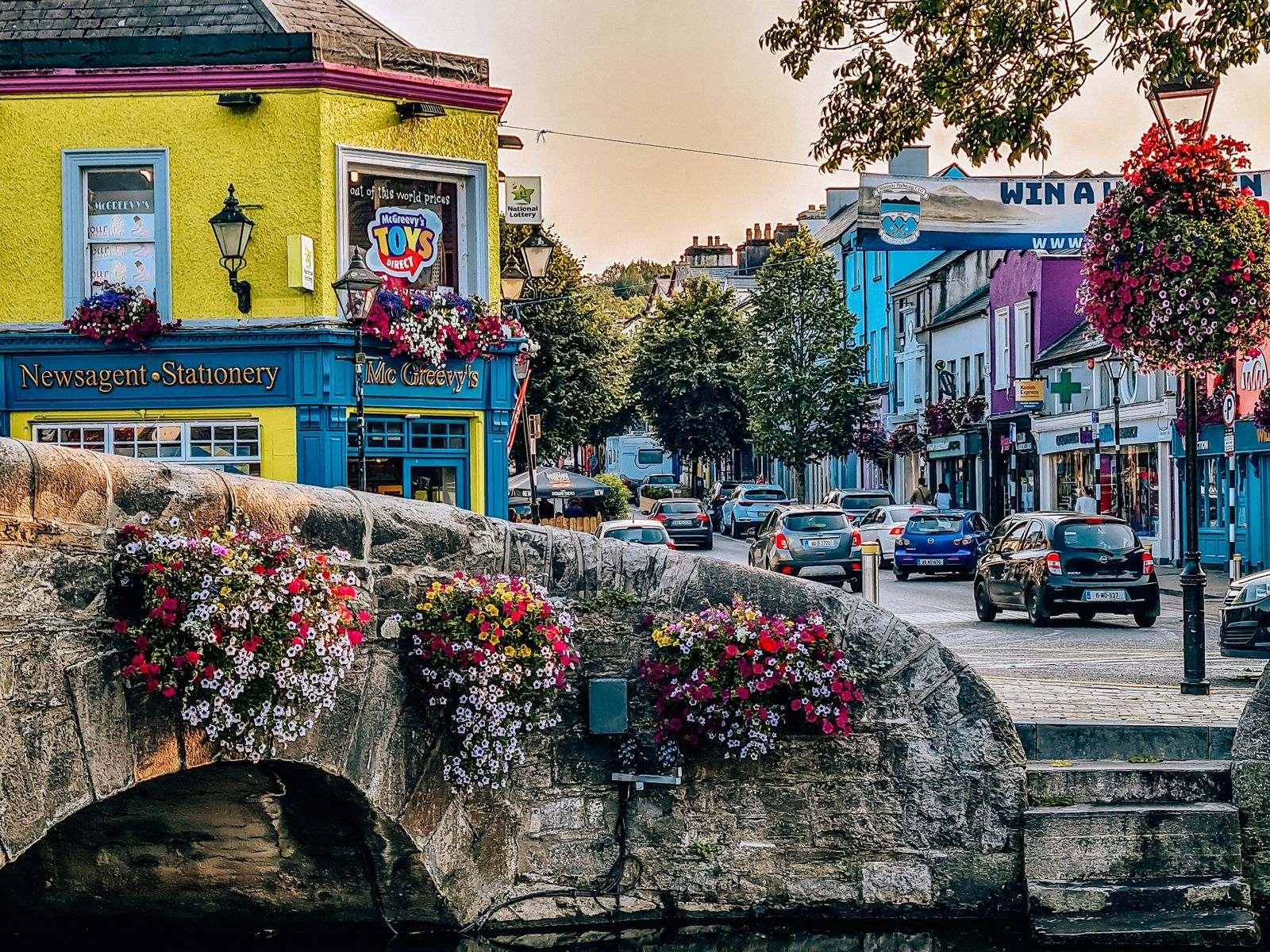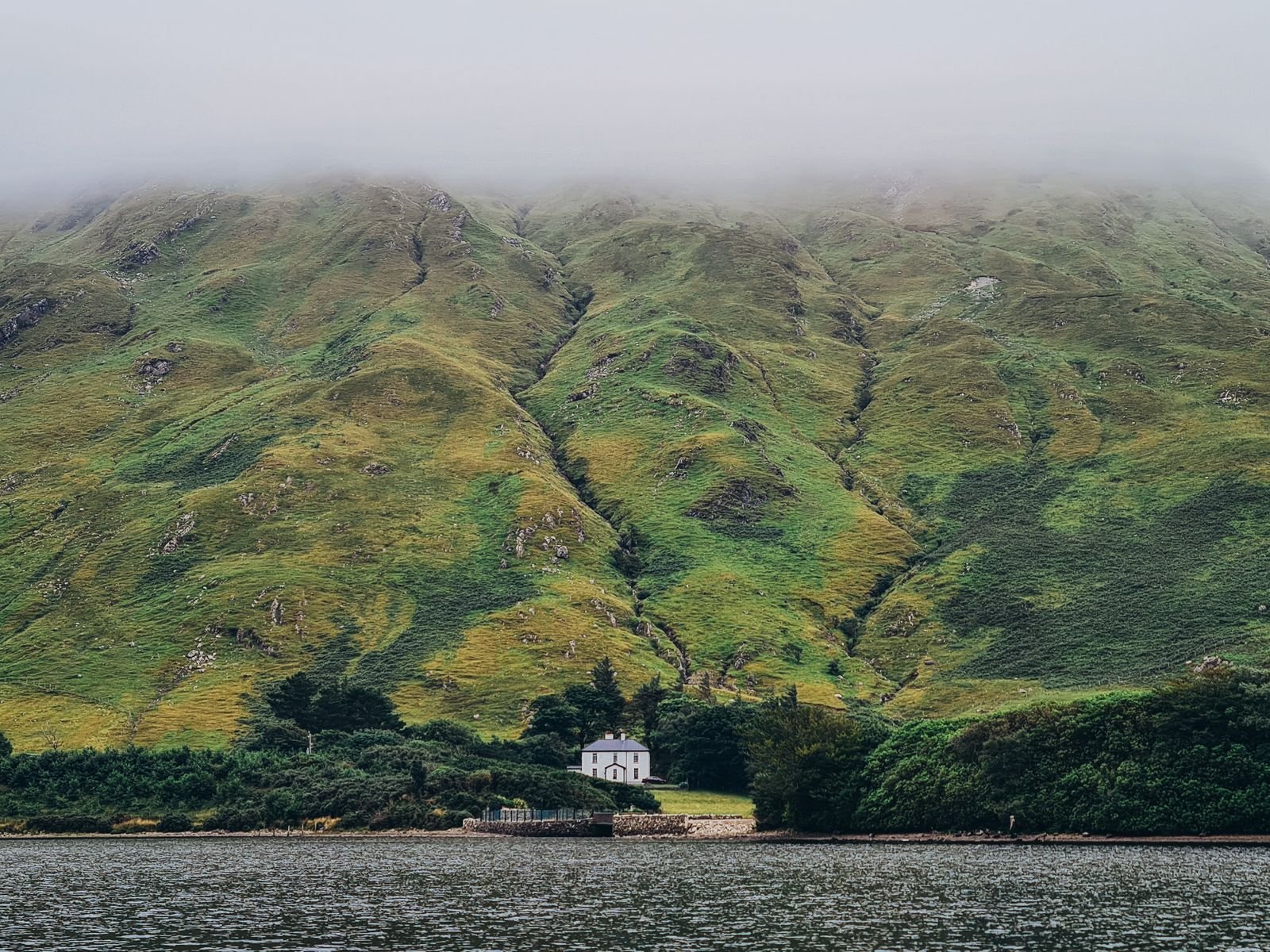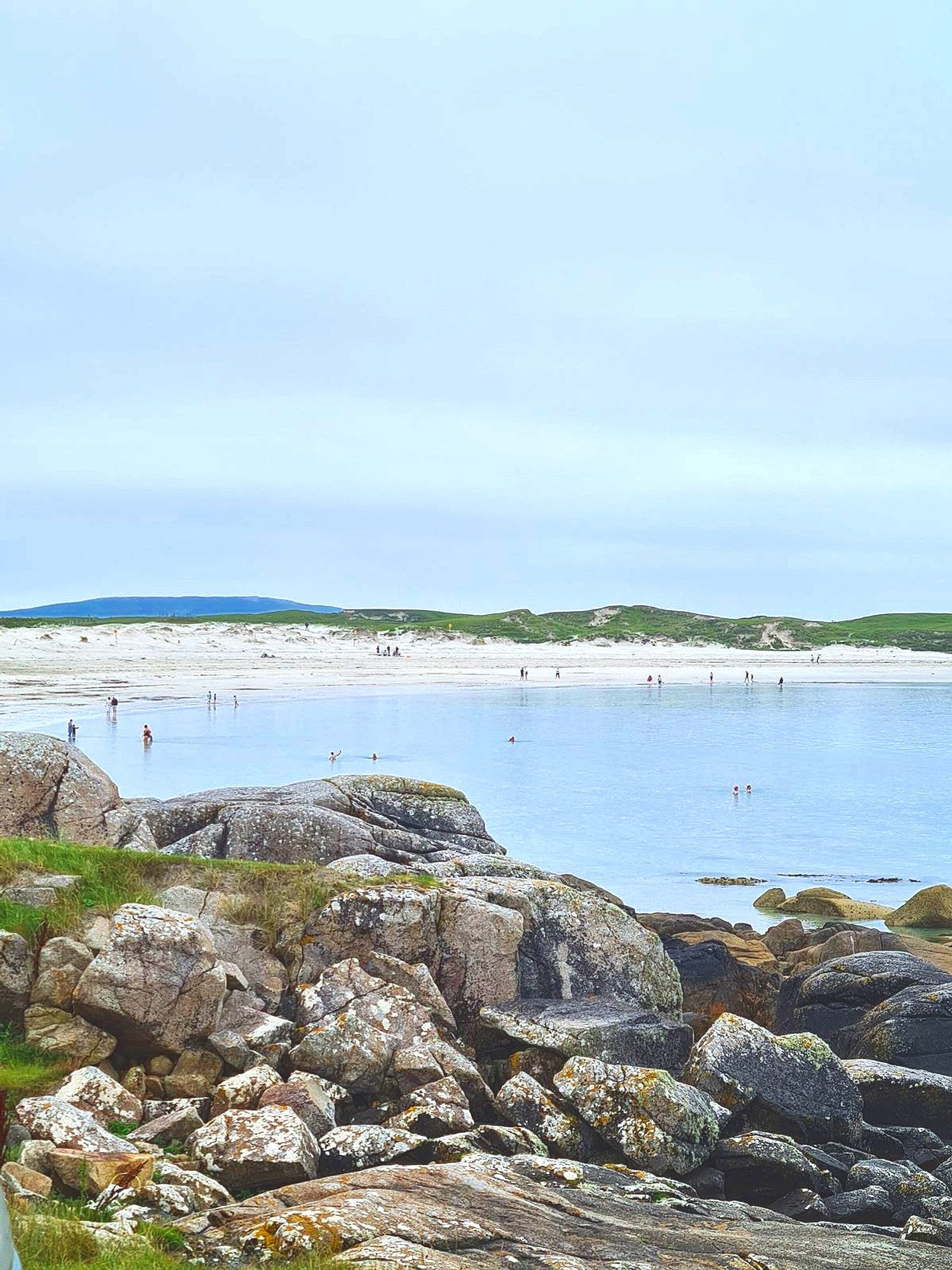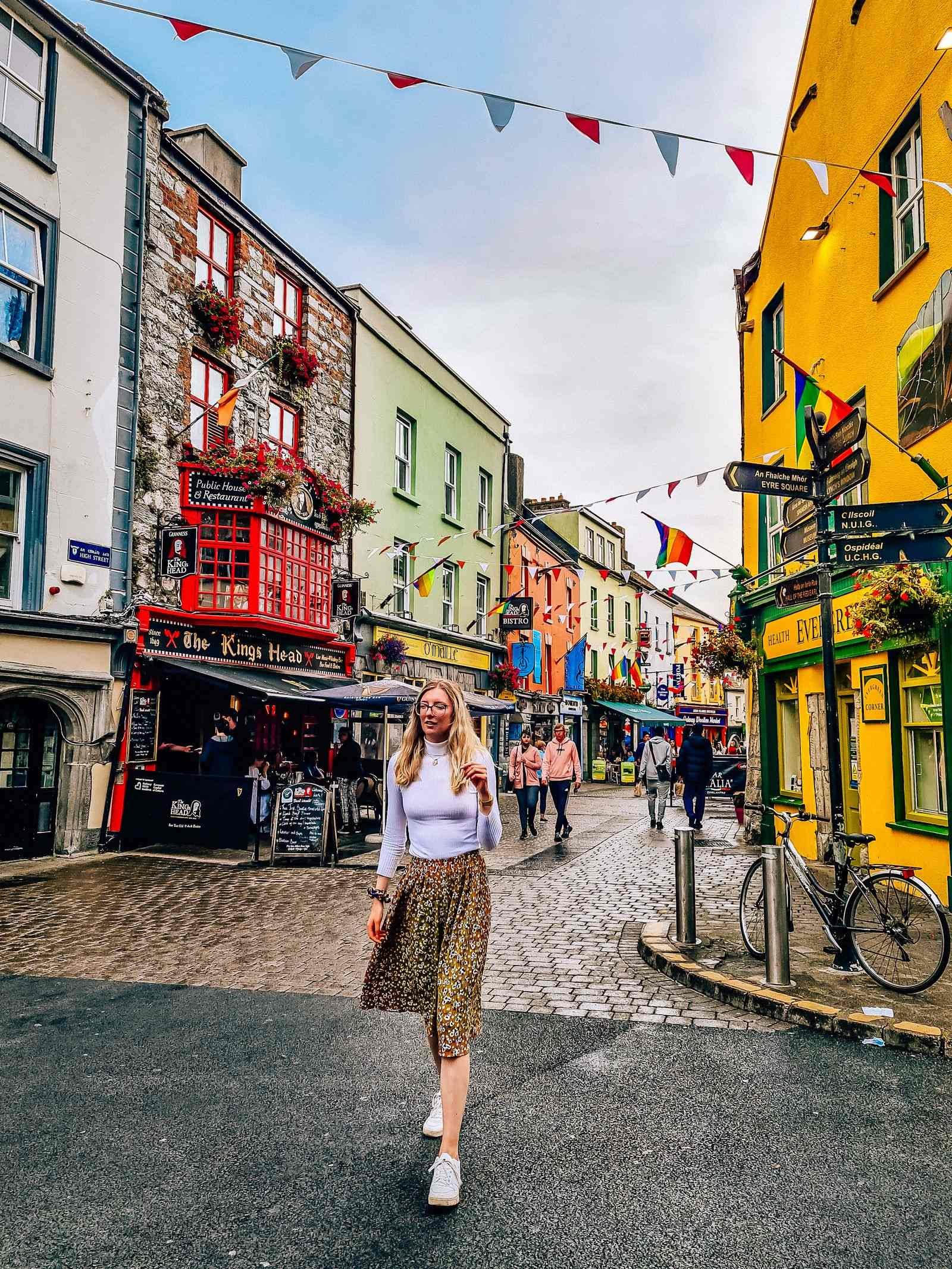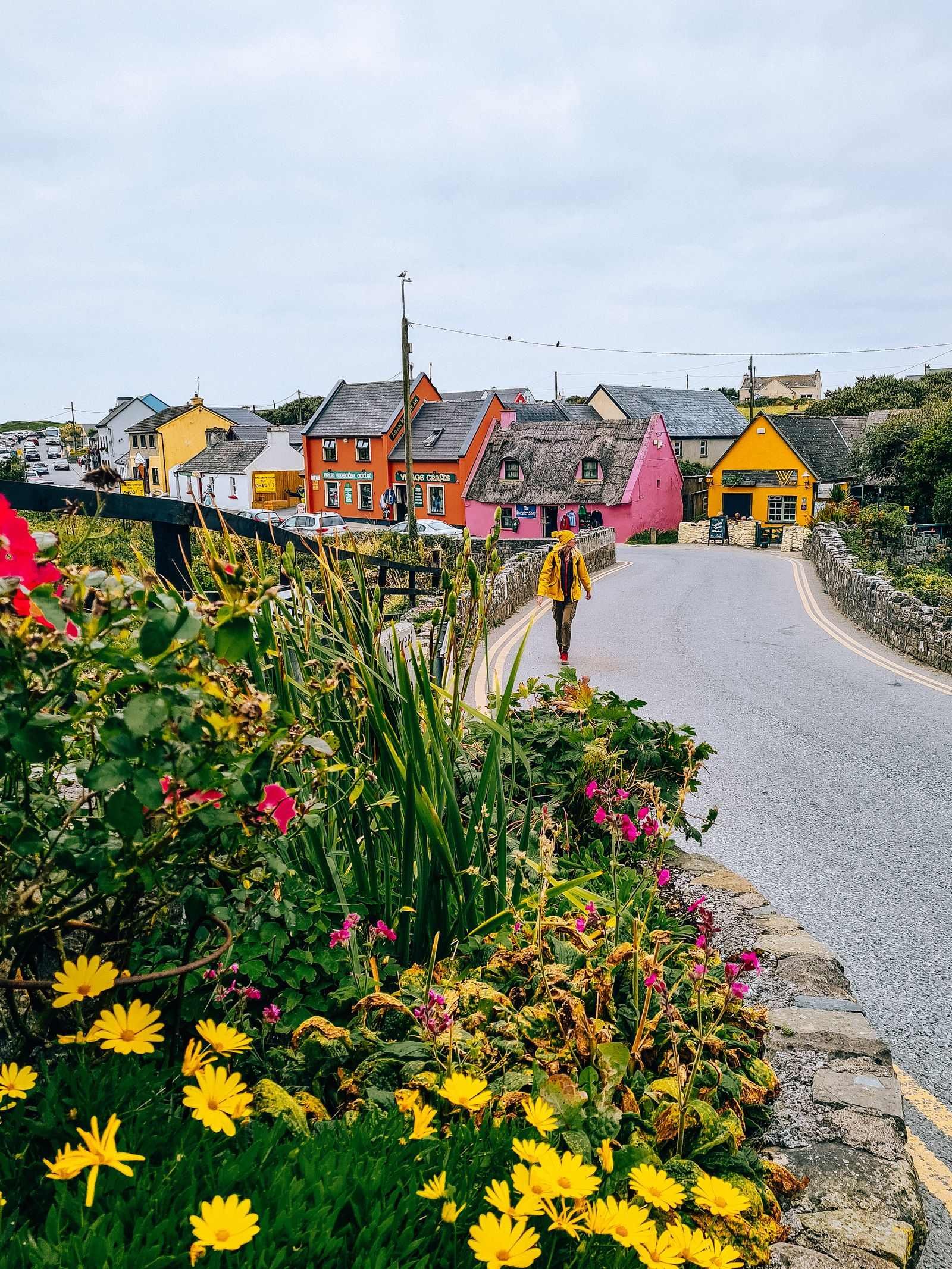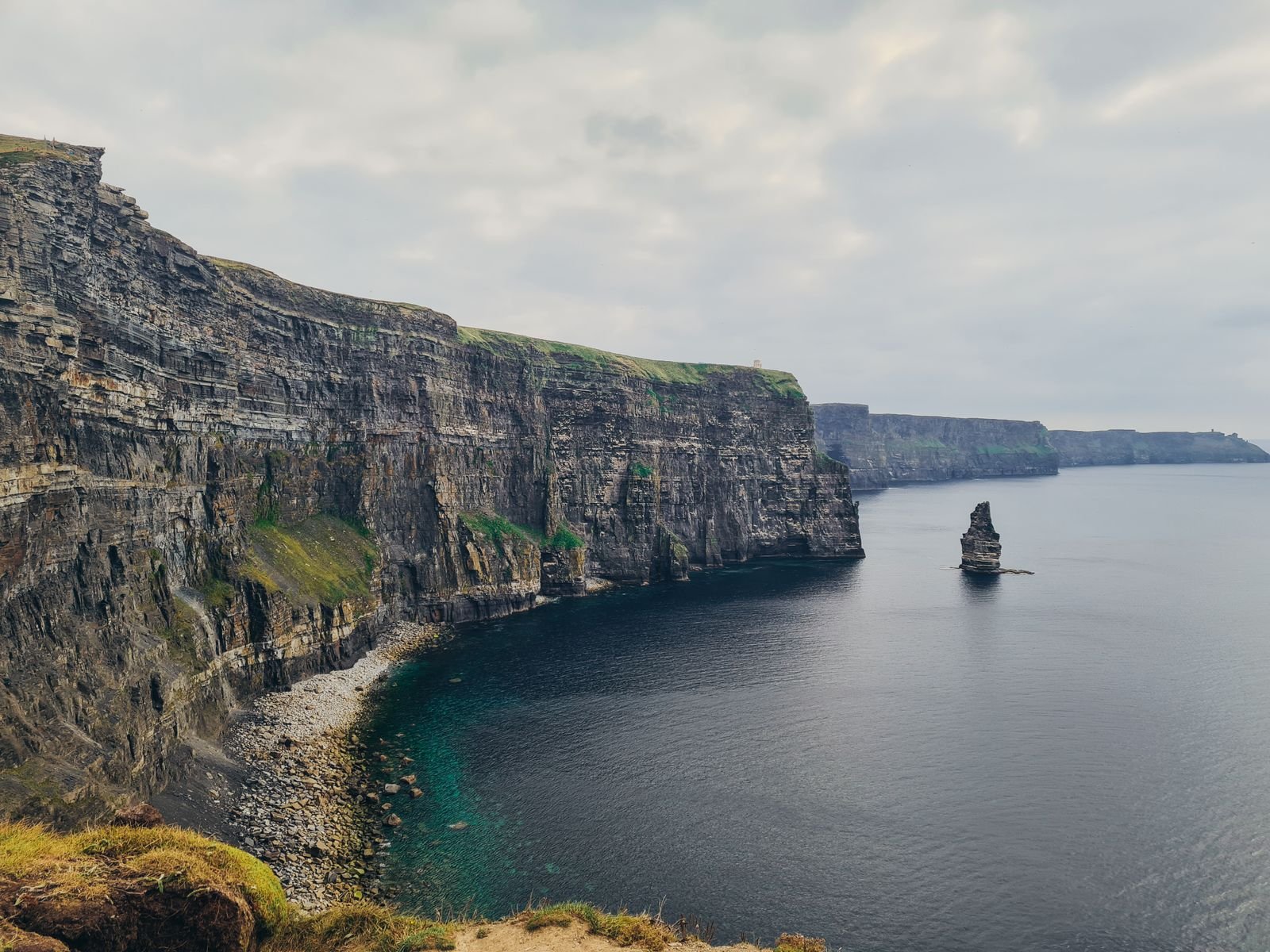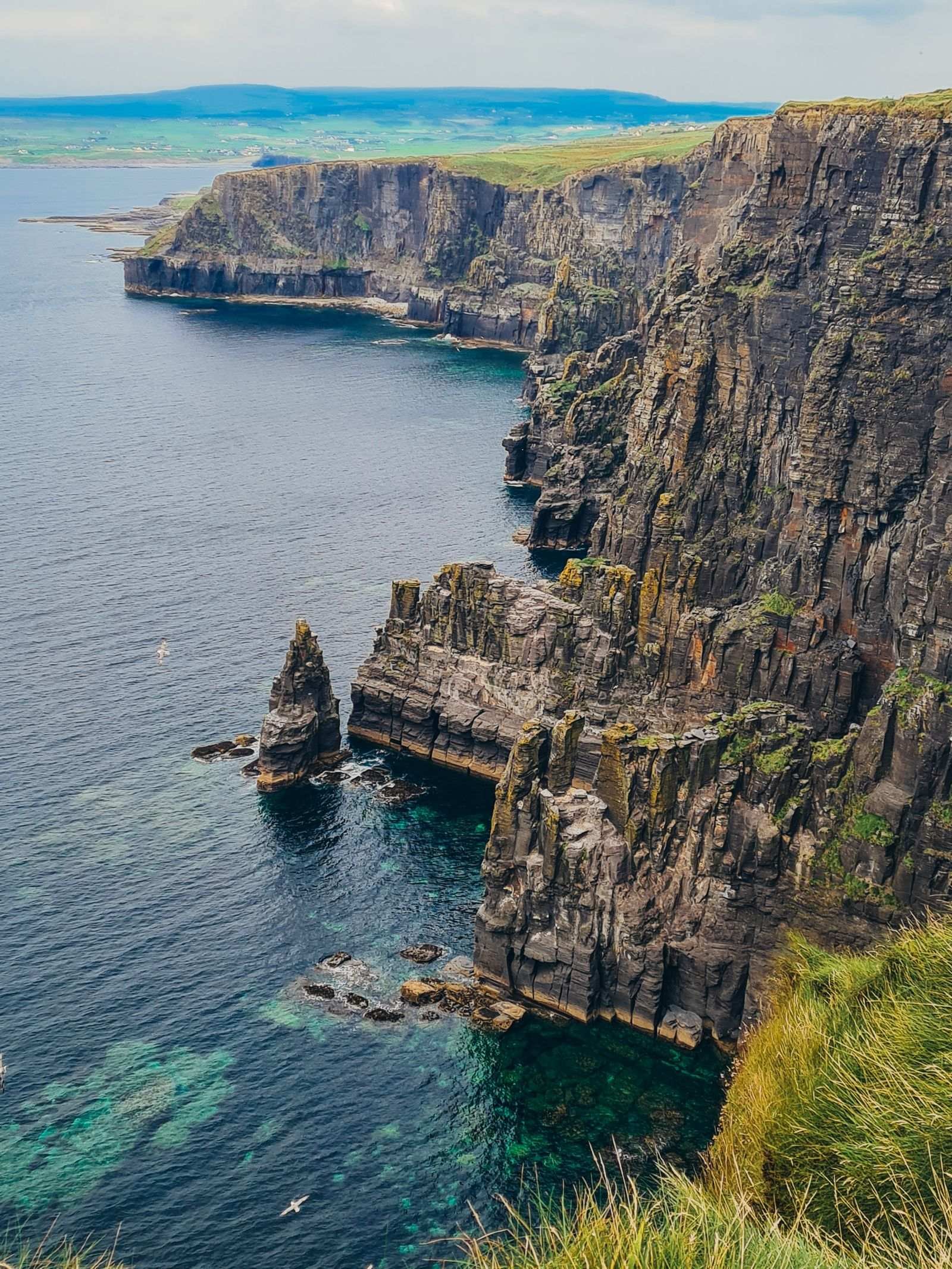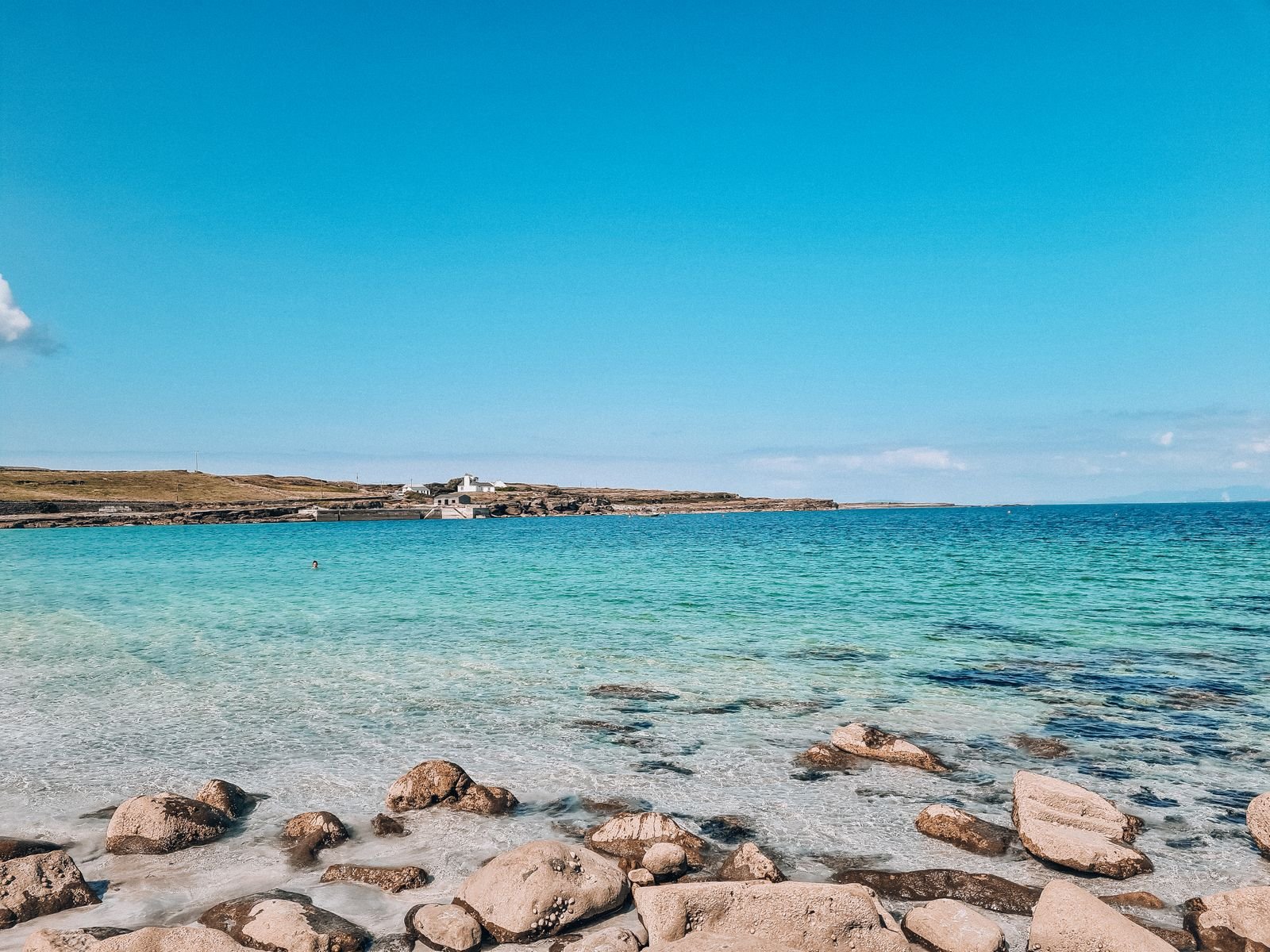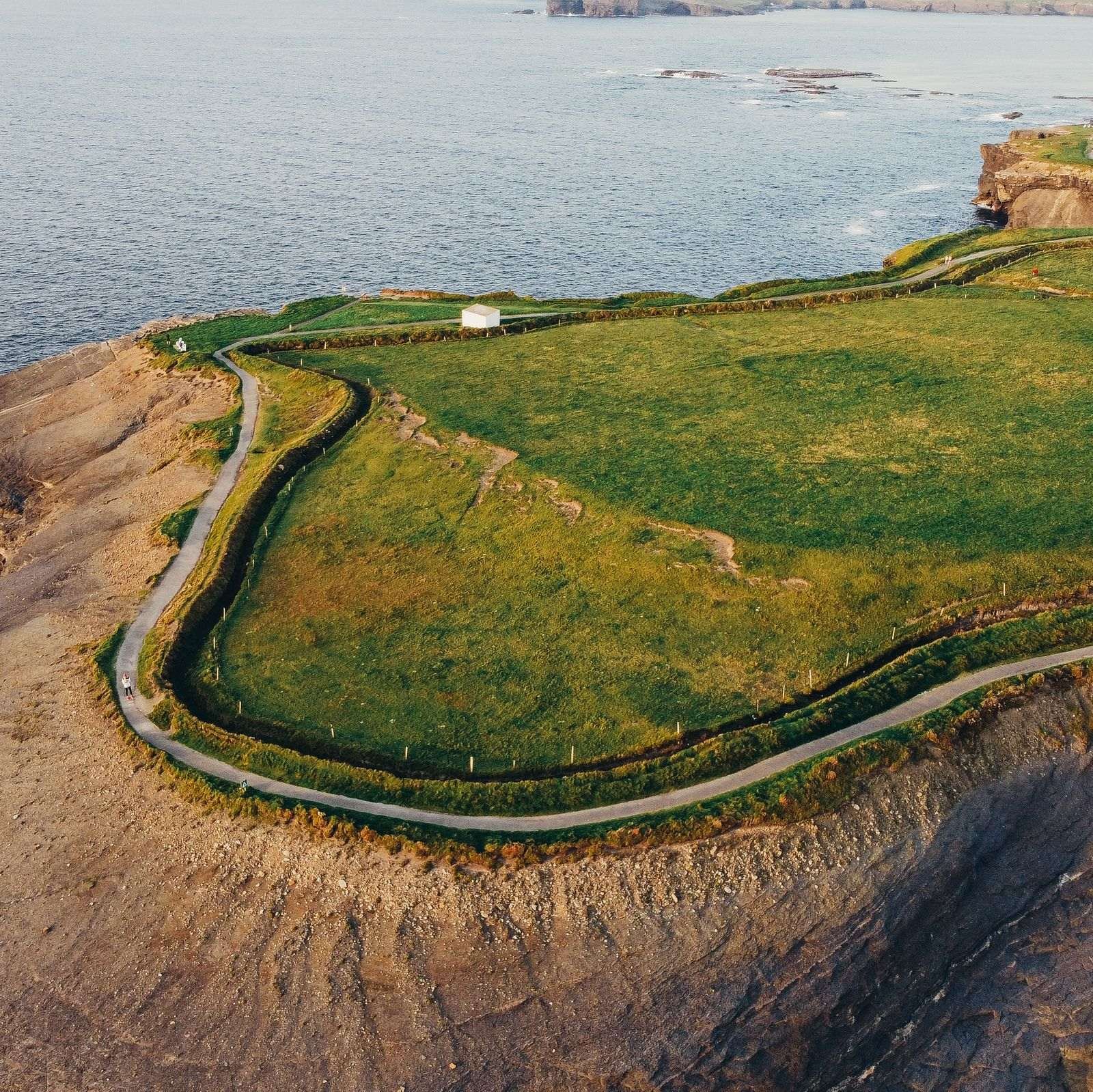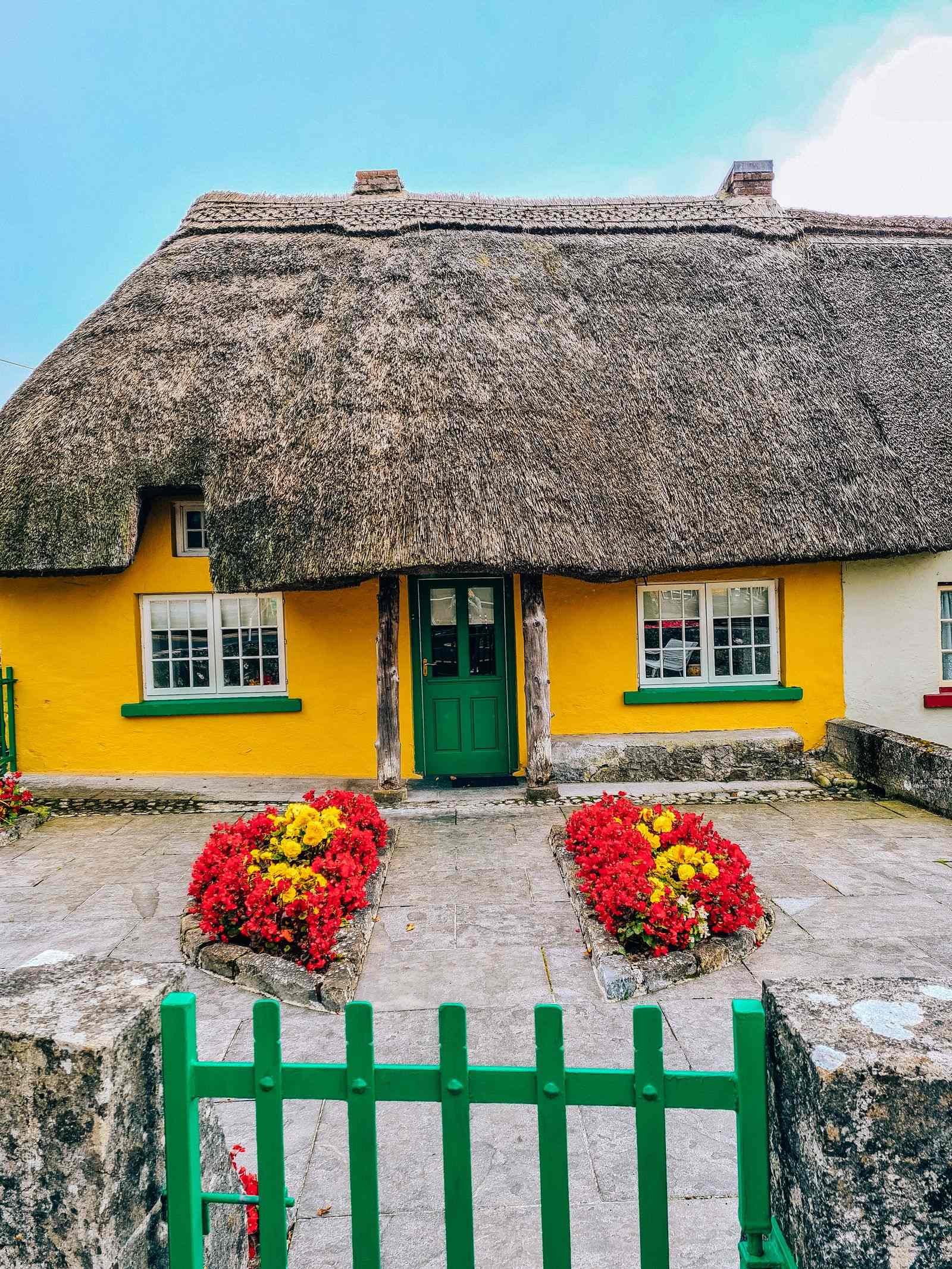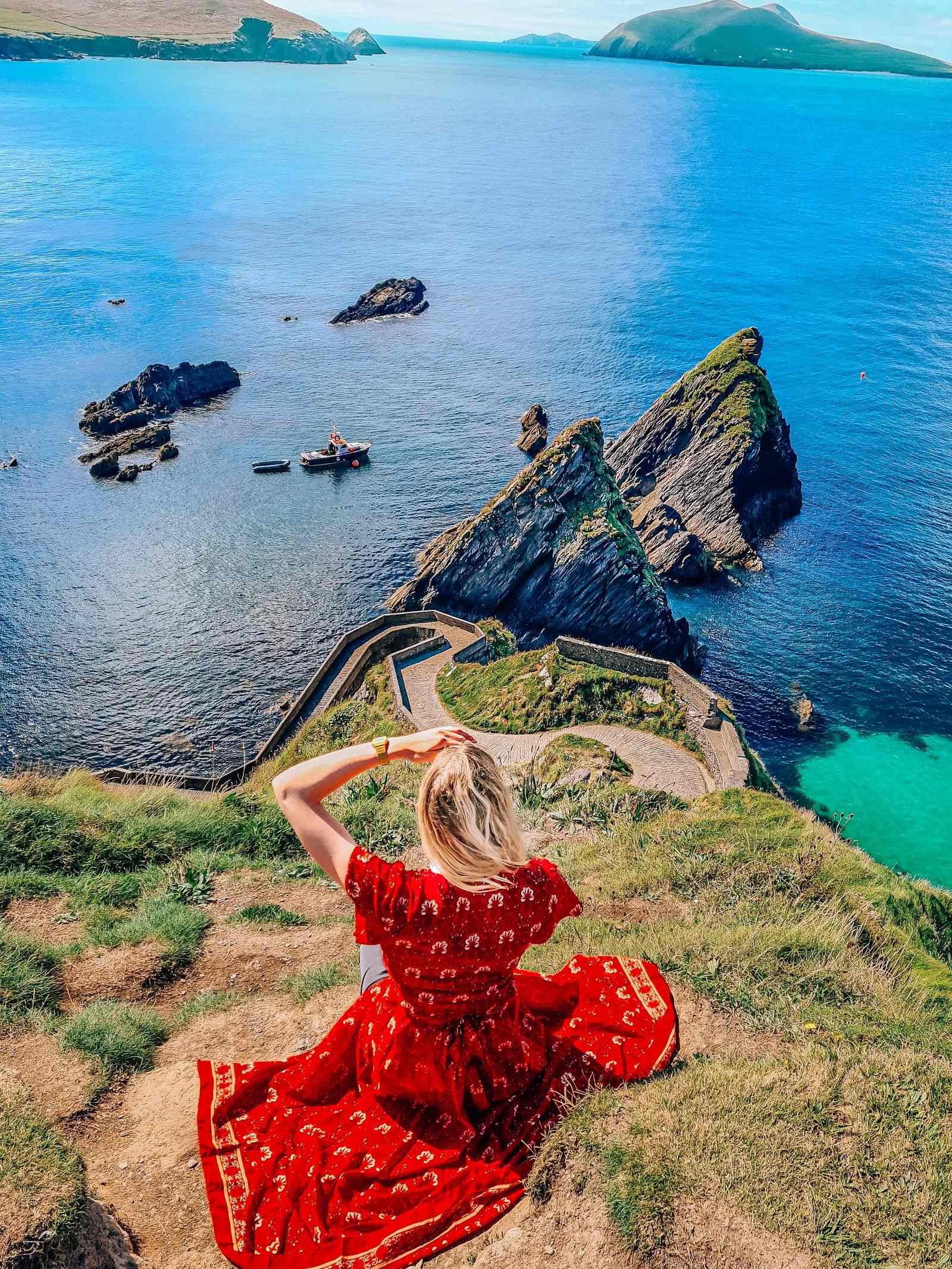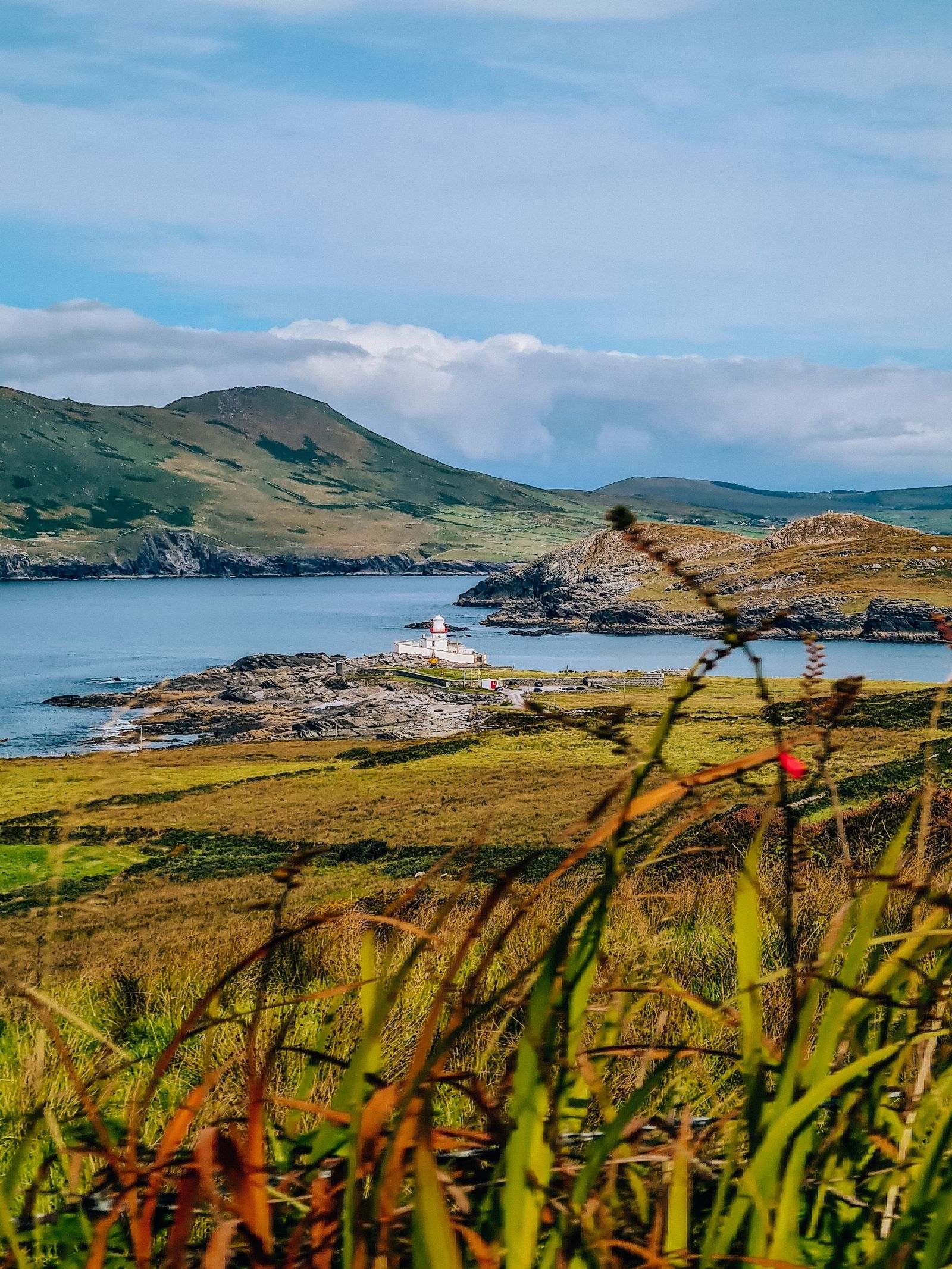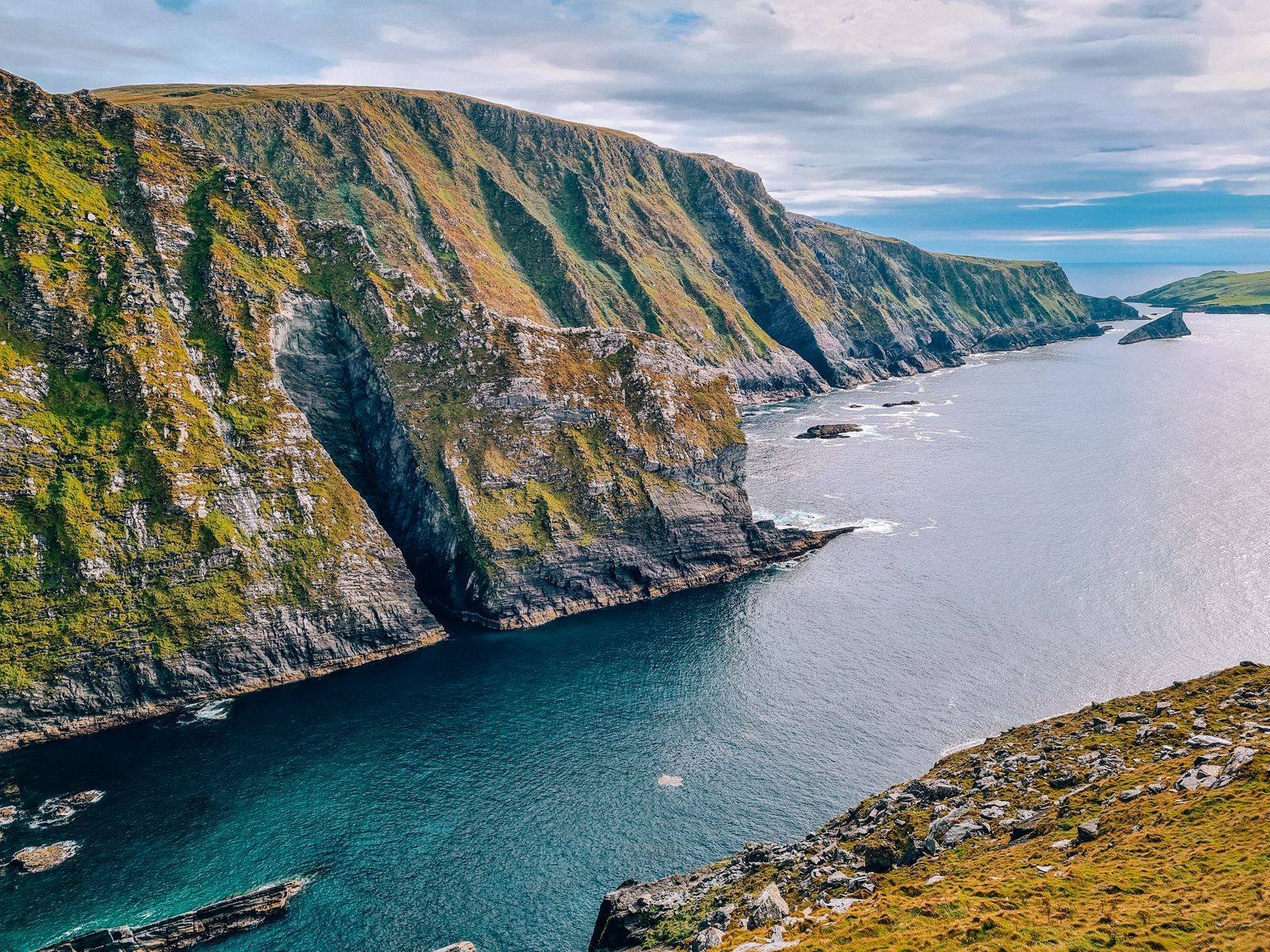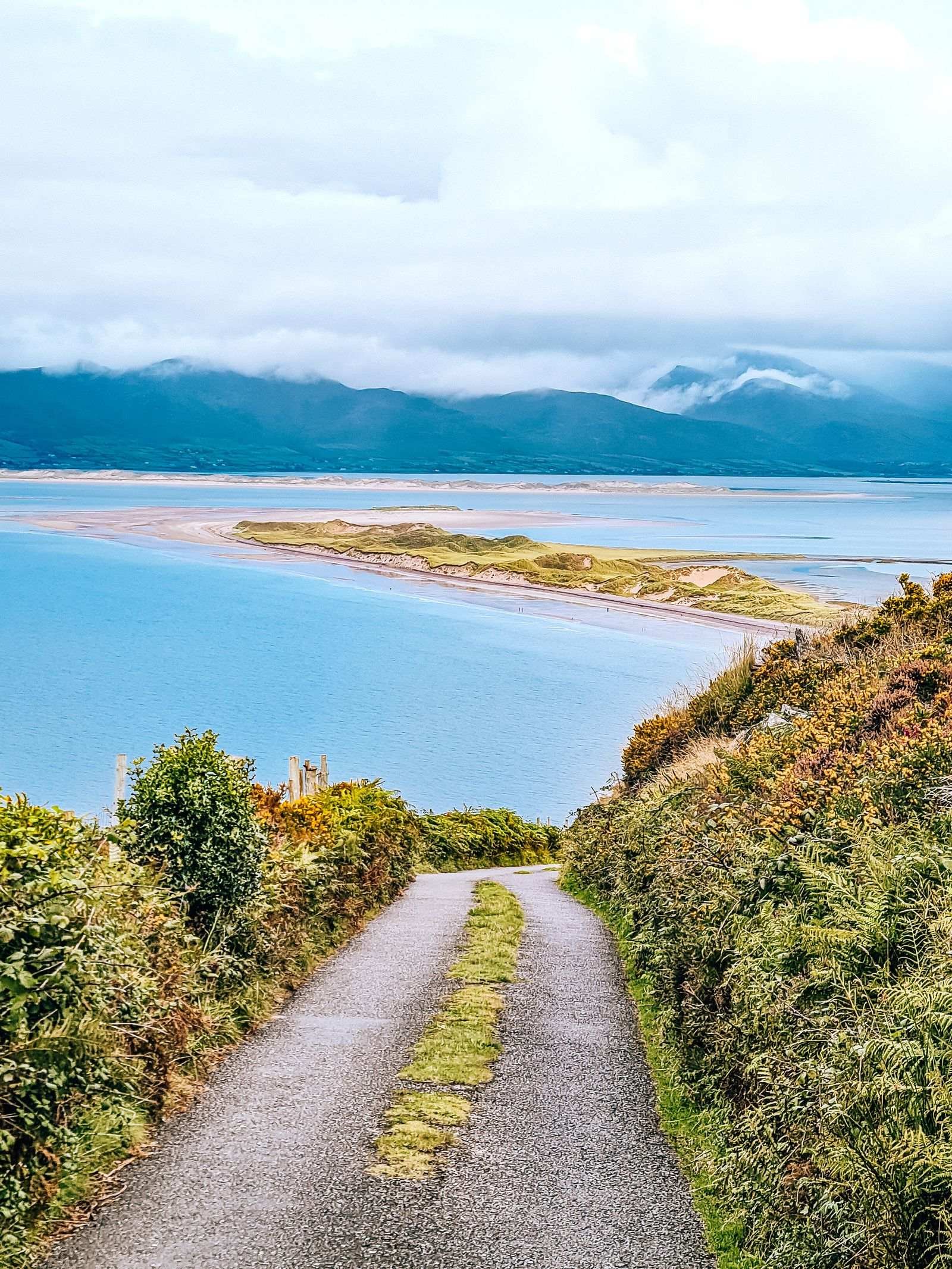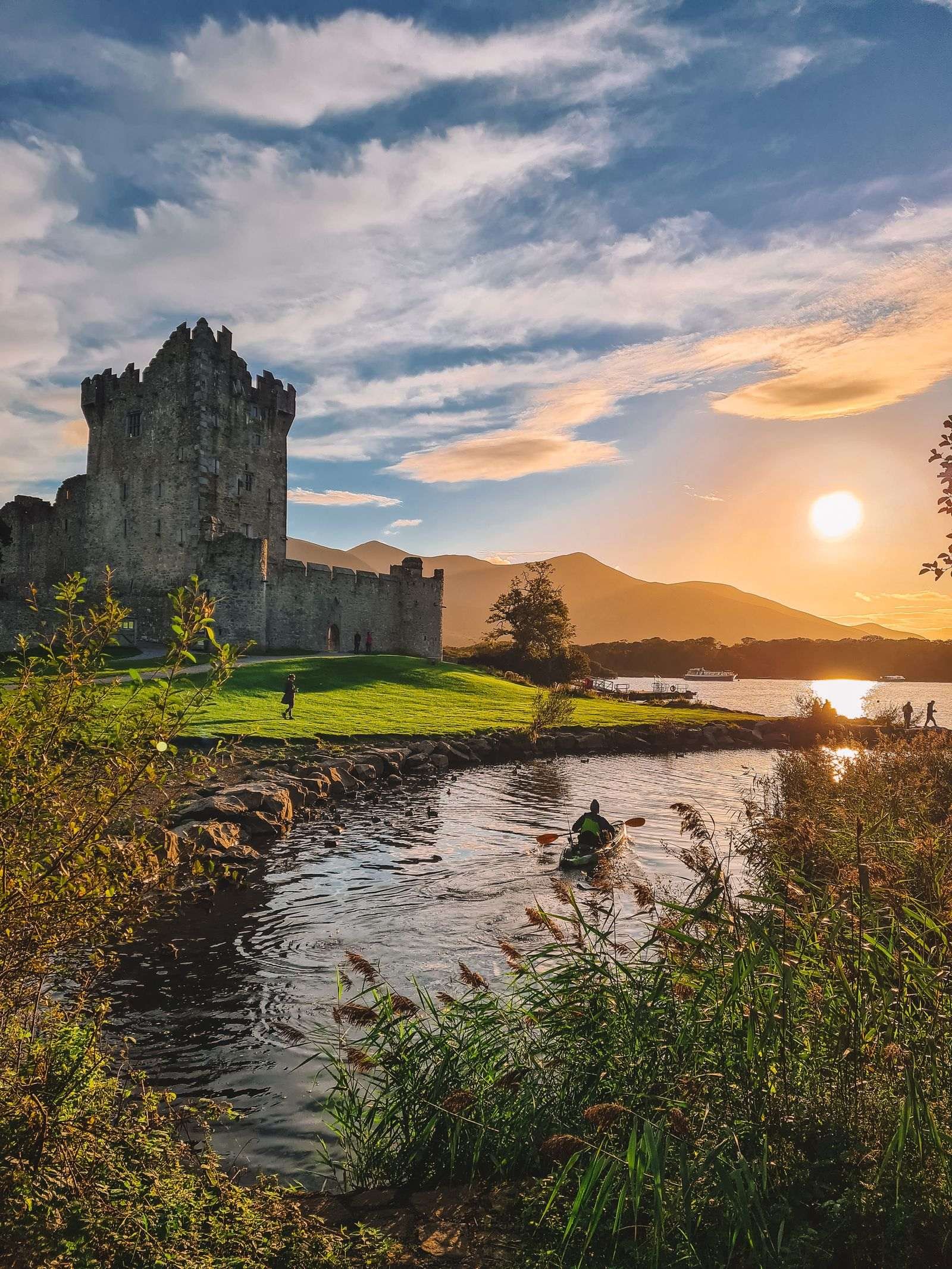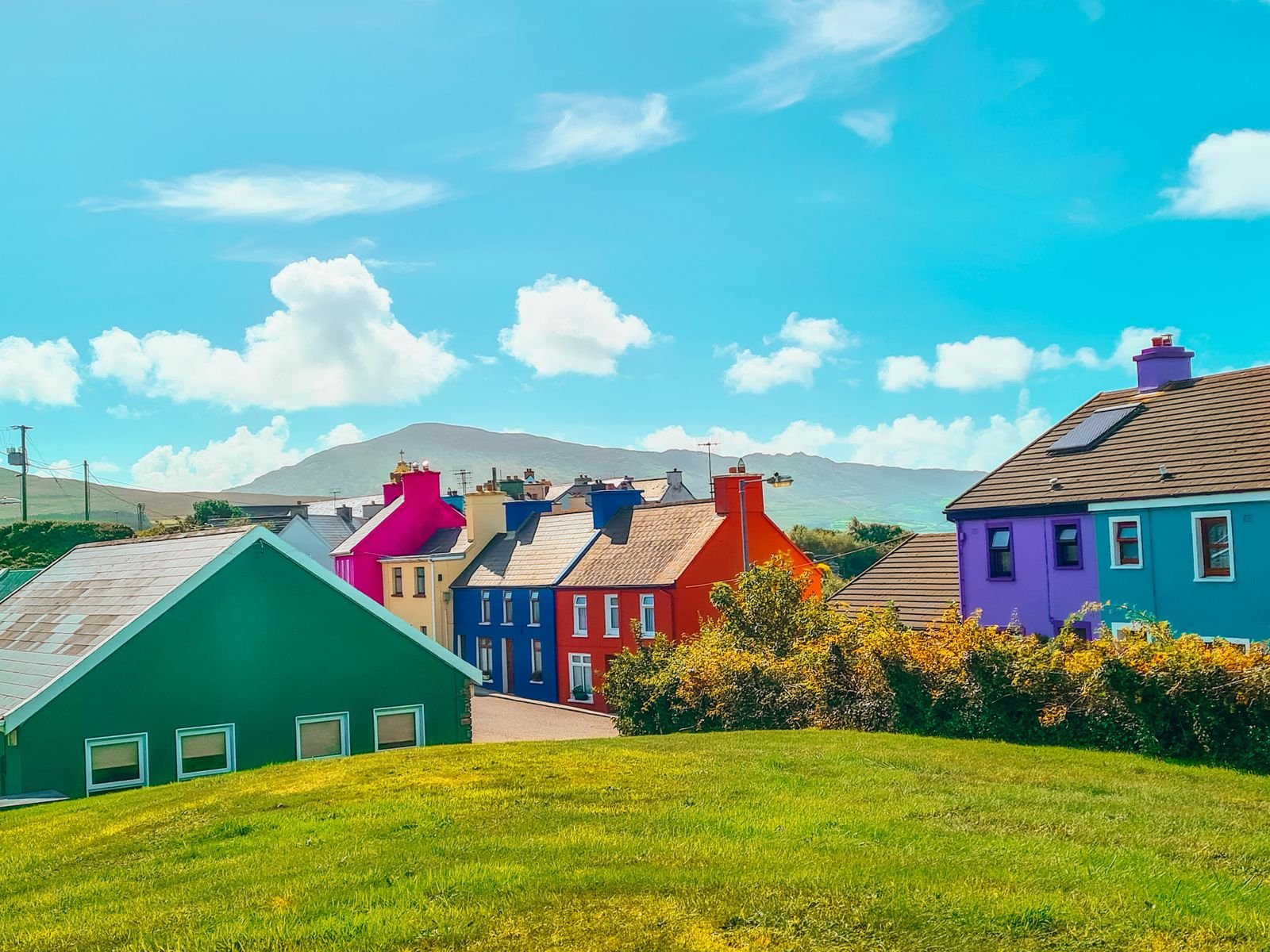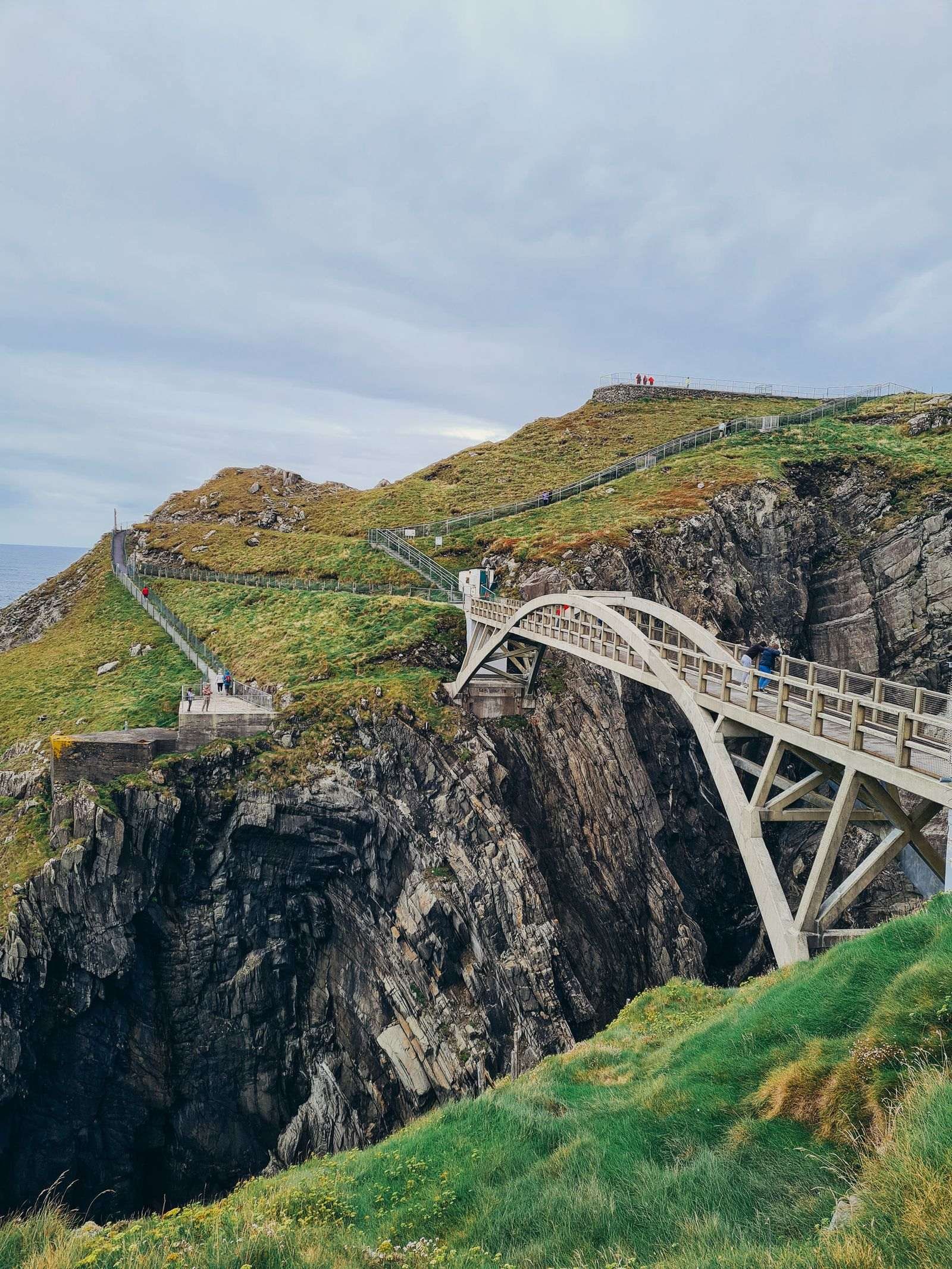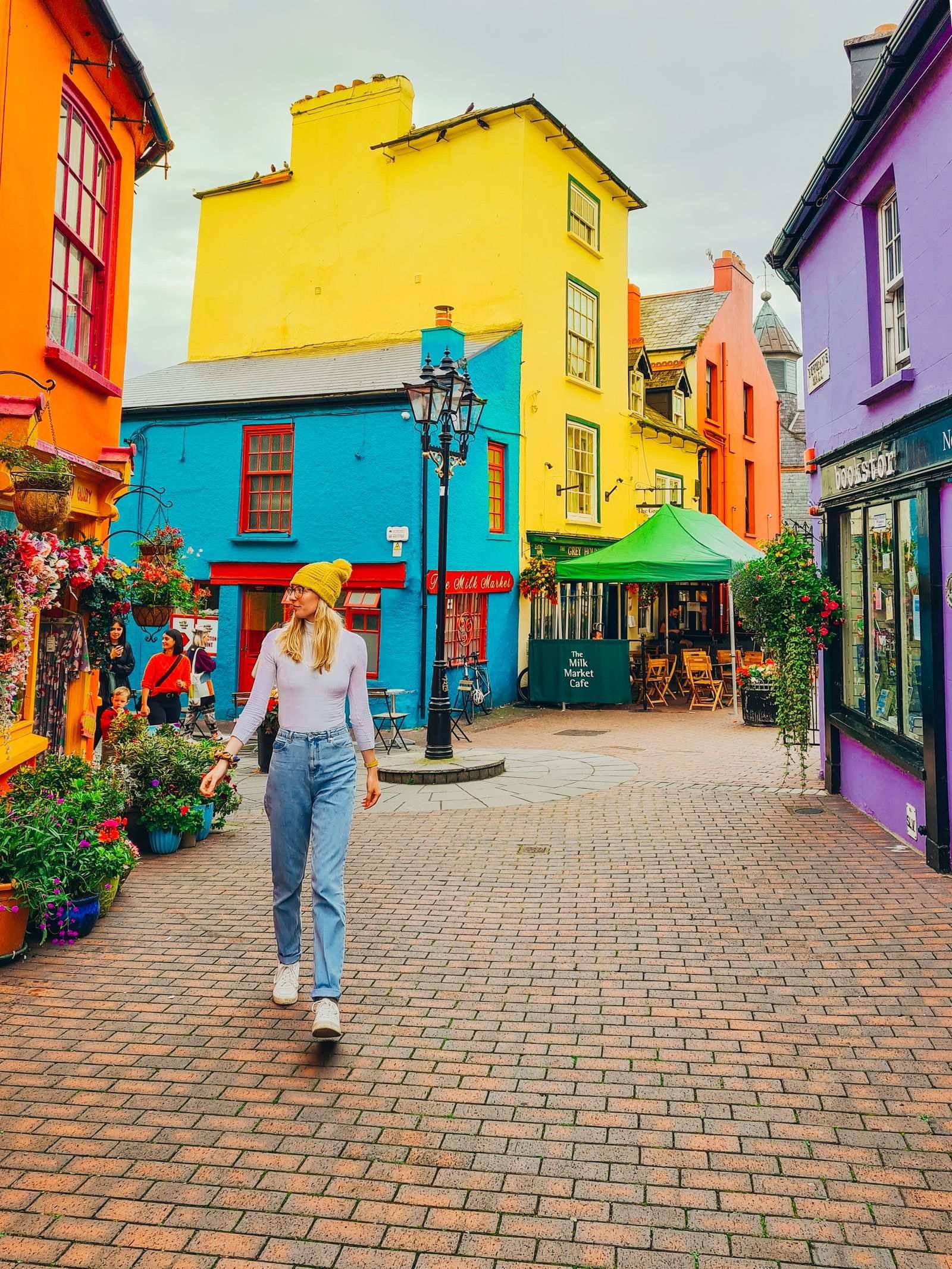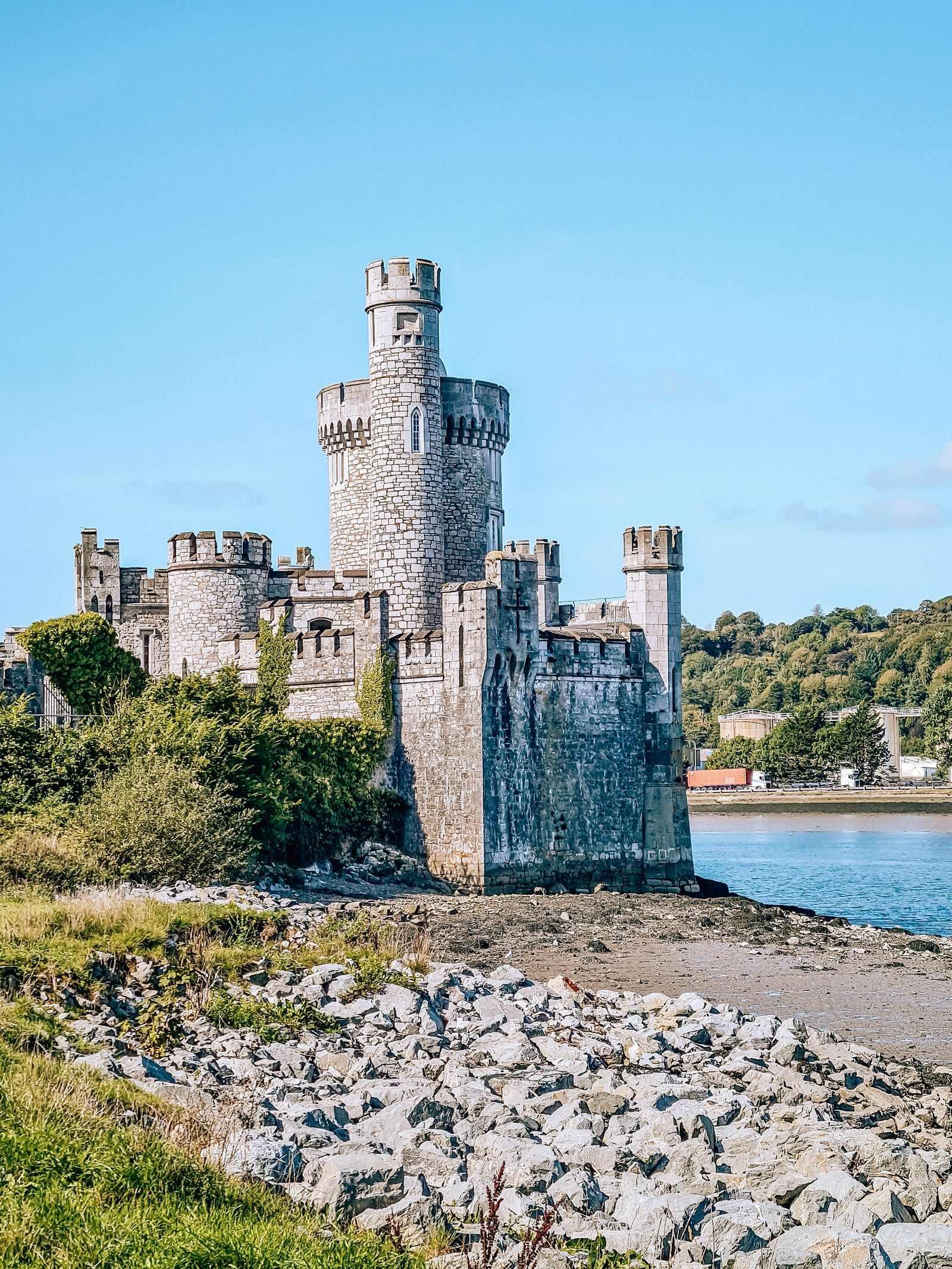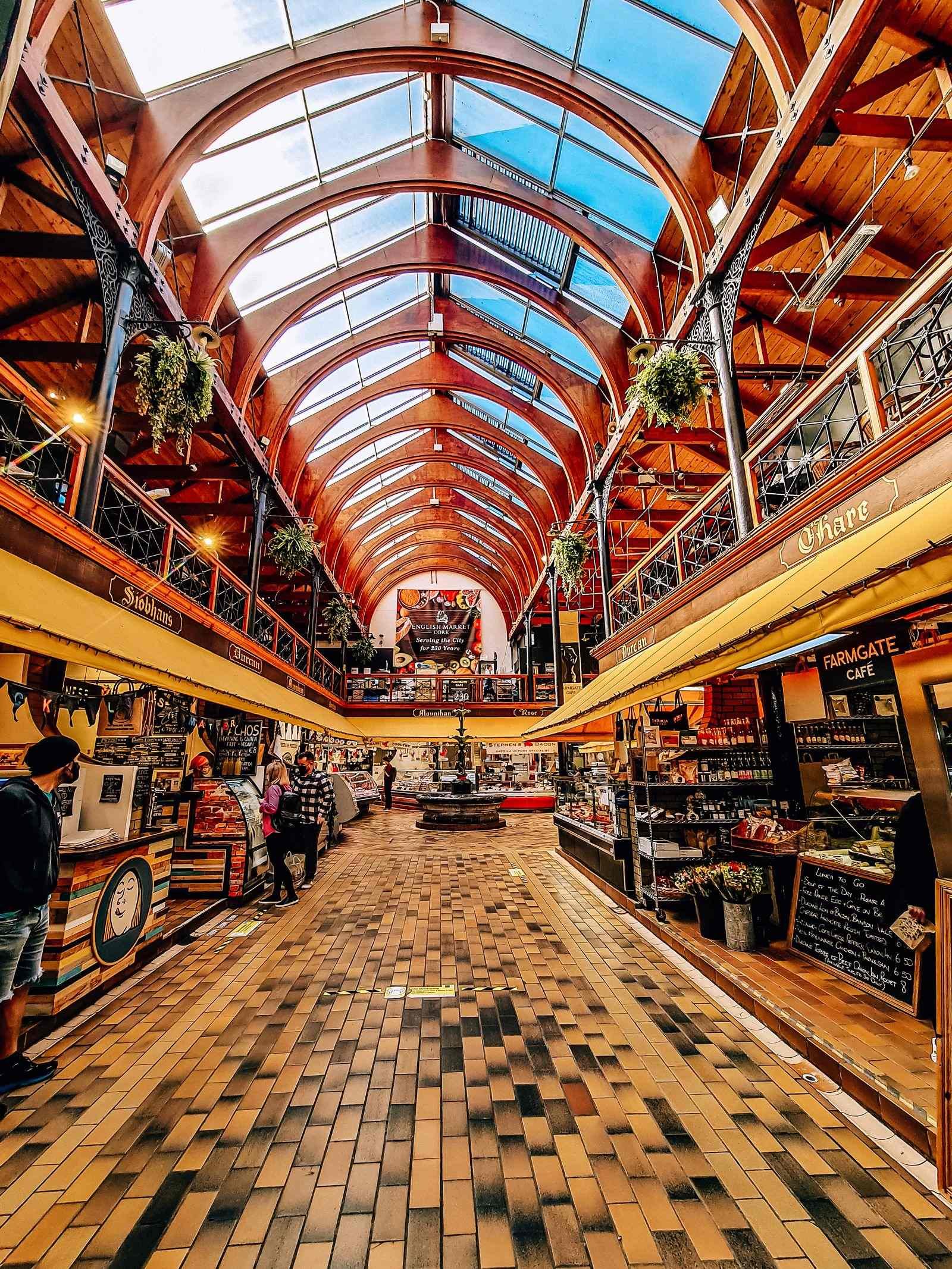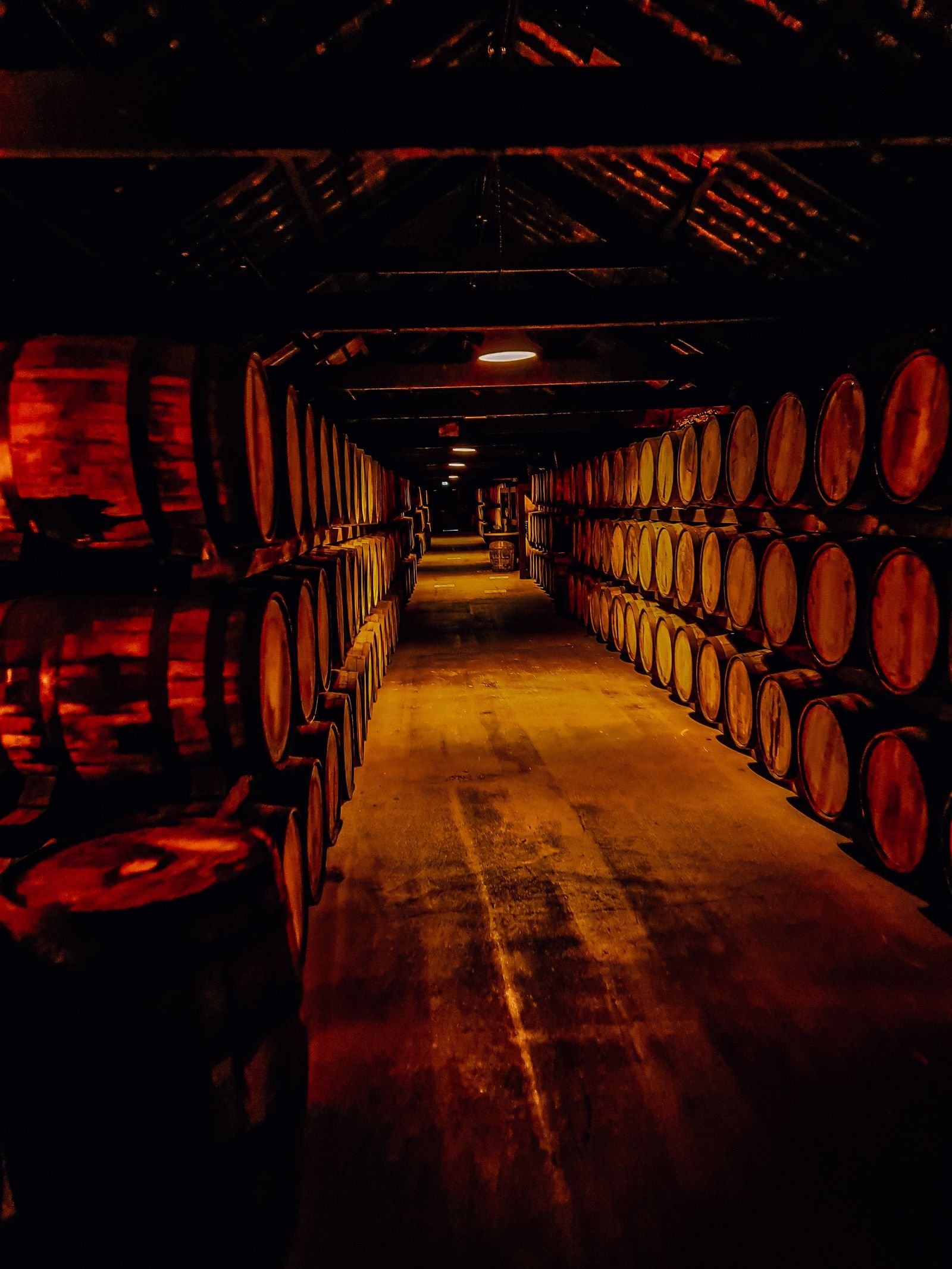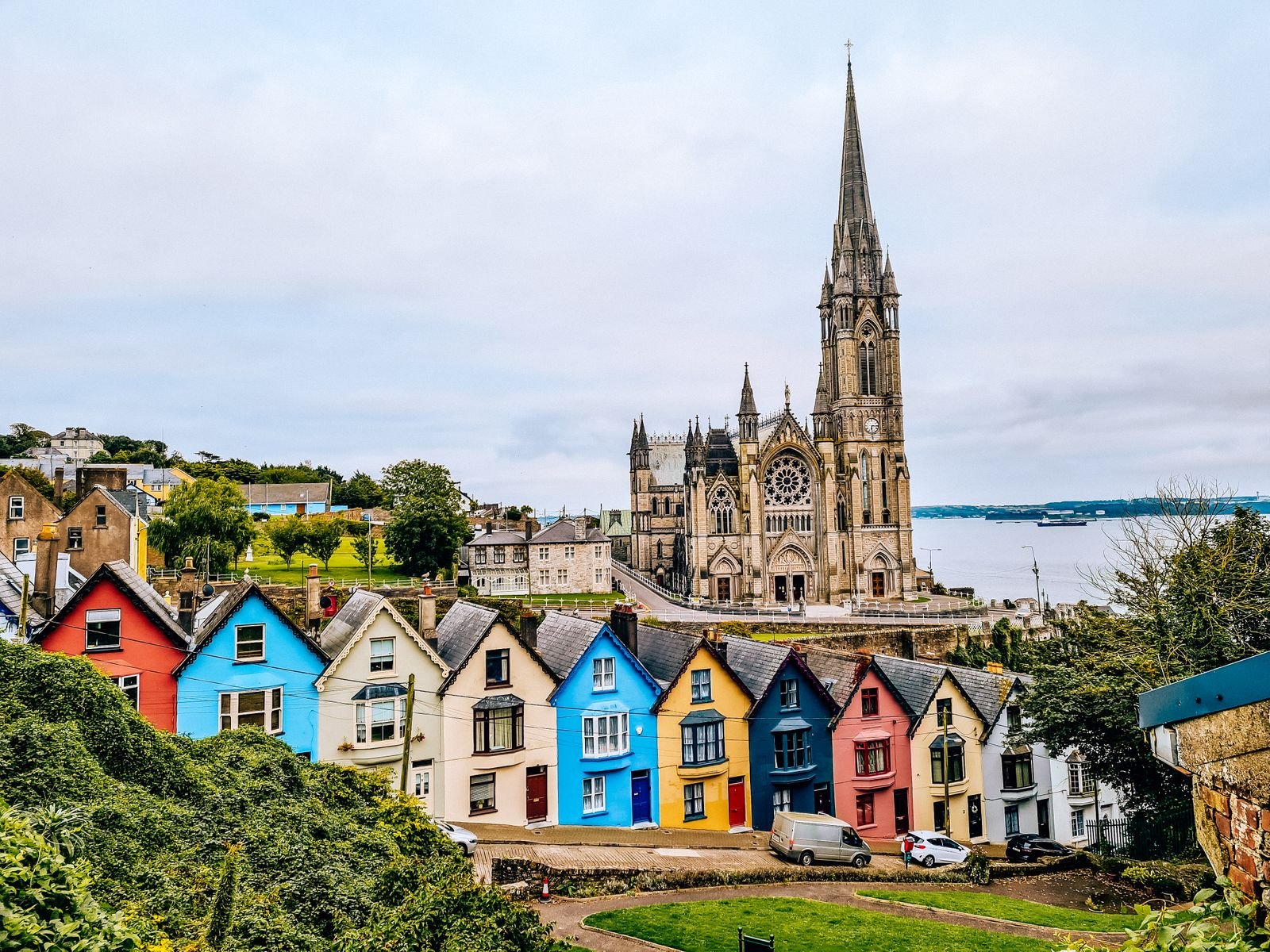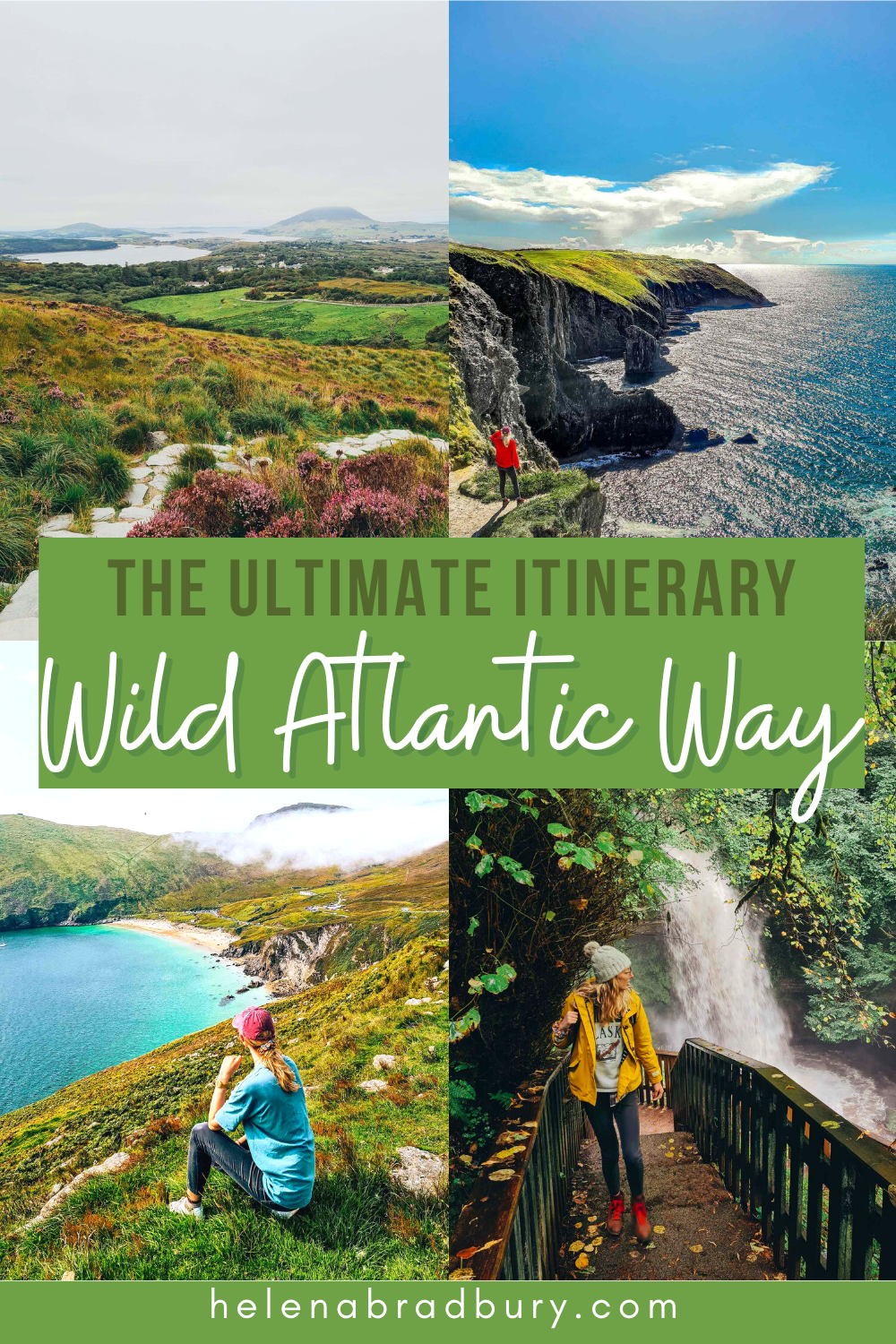Known as the longest continuous driving route in the world, travelling the Wild Atlantic Way, Ireland is a bucket list road trip for many people.
That’s why I’ve put together this ultimate Wild Atlantic Way Itinerary but without a time constraint, my hope is that you can cherry-pick all the stops from this article that you’d like to include in your itinerary.
I spent two months travelling through Ireland and it still didn’t feel like enough to see it all, but whether you’re visiting Ireland for 7 days or 2 weeks, my hope is that this Wild Atlantic Way road trip itinerary will help you pick the best Wild Atlantic Way stops that fit in with where you’re travelling, your own trip plan and budget.
Road in Ireland
Disclosure: This post may contain affiliate links, which means I may receive a commission if you click a link and purchase something. While clicking these links won't cost you anything, they will help me to keep this site up and running! Check out the full disclosure policy for more details. Thank you so much!
Wild Atlantic Way route - which direction to drive?
Wild Atlantic Way road
The Wild Atlantic Way starts in the north of Donegal and runs along the west coast of Ireland, all the way to Kinsale in County Cork on the south coast of Ireland.
However there’s no specific direction you should travel in, you can travel from north to south, or south to north.
I would suggest picking the spots you’d like to see most, then plan your Wild Atlantic Way driving route either travelling north or south, based on those locations you want to visit.
Also consider where are you arriving or departing from - Dublin, Galway or Cork airports? Are you travelling into Northern Ireland to use Belfast airport?
For example, if you are flying in and out of Dublin and choose to cover the southern end of the Wild Atlantic Way so you can visit Cork, the Ring of Kerry, Dingle Peninsula, Cliffs of Moher and Galway, then I would suggest starting in Cork and finishing in Galway. The drive from Galway across the country to Dublin is just 2.5 hours.
If you’re planning to do some of the Causeway Coastal Route in Northern Ireland before continuing onto the Wild Atlantic Way, then I would suggest driving from Derry-Londonderry into Donegal and following the Wild Atlantic Way from North to South.
Wild Atlantic Way Tour
If you perhaps don’t drive or don’t want to drive in Ireland, I’d highly recommend booking a Wild Atlantic Way tour, most of which leave from one of Ireland’s major cities.
If you’re looking for Wild Atlantic Way day tours, Get Your Guide finds the best tours offered by local companies so you can find one that fits with your itinerary.
This Dublin to Cliffs of Moher and Galway tour is the most popular if you’re short on time and basing yourself in Dublin. Or this tour which is a bit more expensive but also includes Kilmacduagh Abbey as well as the Cliffs of Moher and Galway.
If you’re starting from Galway, this day tour from Galway covers the Cliffs of Moher and the Aran Islands as well as a cliffs cruise. Check out my Aran Islands itinerary to see why I love and recommend visiting the Aran Islands so much!
If you’re starting from Galway, I also really recommend visiting Connemara National Park, you can read my review here or book the tour here.
For a multi-day tour that takes you to the Cliffs of Moher, the Burren, Doolin, Dingle Peninsula, Ring of Kerry, Killarney National Park and more, check out this two day Wild Atlantic Way tour from Dublin.
Map of the Wild Atlantic Way, Ireland
The Wild Atlantic Way markers to show points of interest
Here’s a quick screenshot of our Wild Atlantic Way route map and as you can see I have A LOT of pins along the route. There are plenty of options for a map of Wild Atlantic Way. If you prefer a digital version over buying a physical map, I suggest downloading this Wild Atlantic Way map pdf.
The route itself is very easy to follow - just follow the brown Wild Atlantic Way signs with the white zigzag on them - this signifies that you’re on the Wild Atlantic Way route.
You’ll also become accustomed to seeing these metal signs at each stop, viewpoint or point of interest along the Atlantic highway in Ireland - these signify a Discovery Point and we stopped pretty much everytime we saw one, even if it was just to pull over for a quick snap.
The Wild Atlantic Way map route
Best time of year to drive the Atlantic Way in Ireland
Irish weather is famously unpredictable, even if you travel in summer you could be hit with a week of rain, or if you travel in autumn or winter you could get lucky with the weather.
That being said, there’s no wrong time to drive the Atlantic Coast route, you’re more likely to get better weather in the summer, however it’s the most popular time to visit Ireland and some of the coastal roads are narrow and can get busy!
If you plan to do as much outdoor activity as possible, maybe you’re camping or doing multi day hikes then summer and late summer would be a great time to visit.
If you don’t mind unpredictable weather, early spring or autumn are great times to visit. We were there from August to October and although the nice weather was great in August, it was noticeably quieter as we travelled around in late September and October!
The Wild Atlantic Way itinerary and best stops in each county
I’ve divided the following itinerary by county so you can jump to each section if you know which counties you’re going to be in.
This itinerary is also written from North to South just because that’s the direction I did it the Wild Atlantic Way in, however you can do any direction you like!
Wild Atlantic Way: Donegal
Donegal was probably my favourite county that exceeded all my expectations. I had no idea what to expect from Donegal but its wild, rugged beauty blew me away and I’m already planning a trip back in the future.
Malin Head
The northernmost point of Ireland, also called the edge of Europe and it’s where you’ll find the start (or the end!) of the Wild Atlantic Way.
The landscape here is rugged and wild but so beautiful, although it was extremely windy when we visited and it’s very exposed so if the weather is bad - be prepared with good outdoor clothing.
There’s a small car park here and modern toilet facilities. You can explore the ruins of the old signal station which once connected America and Europe.
You’ll also see the first of several ‘EIRE’ signs in large, painted white letters on the ground. These are at several points along the coast of Ireland and were important markers in World War II to signal to pilots that they were flying over neutral territory - Eire = Ireland. Each EIRE sign also has an identifying number for navigational purposes.
Bunbeg Wreck
There’s not a whole lot of information known about this wreck other than it was owned by local fisherman Eddie Gillespie and was wrecked in bad weather during the 1970s.
You’ll find the eerie wreck on Maghercloher beach at Gweedore.
Slieve League
Slieve League view point
If you only visit one place in Donegal, make it Slieve League.
Slieve League is home to some of the highest sea cliffs in Europe and at over 600m tall, they’re nearly 3 times the height of the Cliffs of Moher (214m)
It was the first stop we made in Donegal during our first week in Ireland and it set the bar HIGH. I think visiting Slieve League was part of the reason I felt slightly underwhelmed by the Cliffs of Moher because the sheer size of the cliffs here and the power of the sea are breathtaking.
I recommend parking at the Slieve League car park and walking along the beautiful coastal path to reach the Slieve League viewing platform. This road is completely paved and easily accessible for most people.
Those who wish to continue onwards to hike the cliff trails can do so from the viewing platform, or you can just choose to enjoy the incredible view of the cliffs from the viewing point and the beautiful walk from the car park and back.
Wild Atlantic Way: Leitrim
Glencar Waterfall
Glencar Waterfall
Only a very small portion of County Leitrim reaches the coast of Ireland, but if you are spending some time in the Sligo, Leitrim or Donegal area, I’d recommend visiting the Glencar Waterfall.
The waterfall is just a 15 minute drive from Sligo town.
There’s a large car park, beautiful, lush, green views and the walk to the waterfall is easy and only takes a few minutes from the car park.
In the summer people swim in the waterfall pool.
Wild Atlantic Way: Sligo
Bishops Pool
Sligo is another massively underrated county in Ireland that I fell in love with. If you’re thinking of spending some time here on Ireland’s west coast, plan your County Sligo itinerary here.
Mullaghmore Head
Mullaghmore Head
Mullaghmore Head is a beautiful small peninsula on the Sligo coast, packed with things to do for an afternoon or even a whole day.
Enjoy the views of Classiebawn Castle and learn about its interesting history
Walk the Mullaghmore Head coastal trail
Wild swim in Bishop’s Pool
Relax at Mullaghmore Beach
Streedagh Beach
Slightly further south from Mullaghmore Head, you’ll find the beautiful white sandy stretch of Streedagh Beach.
Popular with swimmers, sunbathers, dog walkers, families and local events, the beach is often busy but with so much space, it’s not crowded at all.
The car park is large, the water was fairly calm and there were no big waves on the days we visited, even when the weather was cloudy. There’s also a lifeguard on duty during peak times.
Streedagh Strand Beach
Benbulbin
Benbulbin
One of my favourite easy walks in Ireland, Benbulbin (or Benbulben) is just a quick 10 minute drive inland from the coast and an easy addition to your Wild Atlantic Way itinerary while you’re in Sligo.
This unique table mountain was formed by glaciers cutting these jagged shapes into the rock during the ice age.
The Benbulben Forest Walk is the walk I recommend, it’s a loop walk along the base of the mountain and back around through the forest, with views of the coast before bringing you back to the car park. It offers beautiful views of the mountain even from the base.
The car park is free but small, so arrive early if you’re travelling in peak season.
You can also climb Benbulben if you wish, although that’s a bit tricker and I suggest going with a local guided group.
Gleniff Horseshoe
Gleniff Horseshoe
Another point that’s slightly in land but just a short drive from Benbulben is Gleniff Horseshoe.
You don’t even need to get out of the car here. This short 10km loop is in a valley of the Dartry Mountains, including Benbulbin, Benwiskin, Tieve Baun and more. I recommend doing the drive clockwise and stopping for plenty of photos!
If you do want to stop for a while, you can do a short walk along the river here, or just follow the road to soak in the spectacular scenery.
You can easily find the route marked on Google Maps.
Wild Atlantic Way: Mayo
County Mayo was another county which I knew very little about before planning my Atlantic route in Ireland and it’s one that I wish I’d spent longer in because there’s so many gems!
Downpatrick Head
Downpatrick Head
Probably the most well-known Wild Atlantic Way stop in County Mayo, this unique sea stack towers 50 metres out of the water.
The natural feature, known as Dún Briste or the Broken Fort, is striking against the backdrop of the Atlantic and is a unique contrast with the strange mossy globes of grass you’ll stand on as you view the sea stack.
The walk to Downpatrick Head cliffs is a short one from the car park, you can also view the caves and the towering cliffs that were the site of the Red Bull Cliff Jumping competition in 2021.
Car parking is free and there are some basic port-a-loo facilities.
Portacloy Beach and Carrowteige
This is a true hidden gem in Ireland, located in North Mayo, it’s formed by Carrowteige Cove and the dramatic Atlantic cliffs here.
Park at Portacloy Beach and follow the arrows to follow the loop walk counterclockwise.
The coastal views here are spectacular and much less busy than other popular areas in Kerry or Clare.
You’ll also see another EIRE sign, this one is EIRE 63 as you enjoy the cliff walk and views of the beautiful bay below.
Achill Island
Keem Beach
Achill Island is the largest island of Ireland, covering almost 150km2.
There’s a bridge that connects Achill Island to the mainland so you can easily drive across and explore this beautiful area of Ireland. Here are my top recommendations if you spend a day on Achill Island:
Visit the beautiful Keem Beach
Rent a stand up paddleboard or kayak on Keel Lough
Keel Beach
Visit the Slievemore Deserted Village
HIke to the Cliffs of Croaghaun
Westport
Westport
Westport was such an unexpected treat to visit!
I had no expectations of it, it was just where to choose to stay in Mayo but this vibrant town is so much fun and I really recommend paying a visit even if you’re not staying overnight.
The colourful main streets are super fun to wander and explore the shops, restaurants and bars. Here’s my top tips for spending some time in Westport:
Take a stroll along the Carrowbeg River
Get some great burgers and Irish food at Cian’s on Bridge Street
Walk along Bridge Street and the High Street
See the Clock Tower
Visit Westport House
Silver Strand and Lost Valley
This is an amazing Irish beach hidden gem, with golden sand, epic dunes and amazing views of the ocean and the Connacht mountains.
The water is beautifully clear and the sandy beach is great for families and friends alike.
It’s located by the Lost Valley where you can do a walking tour, see an abandoned famine village and learn about the Irish famine, see the working farm and hear a true insight into a significant part of Irish history from the husband-and-wife duo living there.
If you’re looking for an authentic Irish experience during your Wild Atlantic Way road trip, this is it!
Wild Atlantic Way: Galway
Of course everyone knows Galway City and it is well-worth visiting, but there’s also a lot more to County Galway.
If you’ve come from Mayo, I recommend just taking the afternoon to drive to Galway via the Westport to Clifden road, the scenery here as you drive through the Connemara National Park is spectacular - a worthy longer way round on your Wild Atlantic Way road trip route!
Connemara National Park
Connemara National Park
One of the most underrated places to visit in Ireland, Connemara National Park is a stunning area of natural beauty made up of lakes, marshy bogland, the Twelve Ben Mountain range and is one of the few areas still speaking the Gaelic language.
I highly recommend visiting Kylemore Abbey and doing one of the walks up Diamond Hill - the walk to the top is short but can be tricky for some. However there are three well-marked alternative routes with well-maintained trails that are family and dog friendly - perfect for a short walk. We did the blue trail which was around 2km.
If you want to find out more about Connemara or do a day tour, check out my tour review here.
Sky Road
A super easy addition to your Galway itinerary that offers spectacular views on an easy loop drive.
You’ll find the Sky Road well-signposted off the N59 road just before reaching Clifden if you’ve driven from Westport via Connemara National Park.
This single track road feels like a true rural escape with epic west coast views as this road loops around the small peninsula, I recommend driving it anticlockwise.
Make sure to stop at the viewpoint towards the end, you’ll see the Wild Atlantic Way signpost.
Dog’s Bay
Dogs Bay
If you’re looking for the best beaches in Ireland, this is a must-stop - especially in the summer!
This unique beach is a stretch of sand, like a sandbar with a bay on either side.
It is a bit of a detour to the south of Clifden but the coastline here is spectacular.
Unfortunately even in the summer we were unlucky and ended up visiting on a cloudy day, but even then the car park was packed and it’s a single track road down to the car park - I don’t recommend attempting to park there unless you plan on arriving at 8am or in the off season.
At midday on a Friday in the summer, it was STRESSFUL trying to reverse all the way back up the single track road to the main road!
If you’re in the area, also check out Roundstone, a town with a cute harbour. Or stay overnight at Gurteen Bay campsite if you want to spend longer in the area.
Galway
Galway Latin Quarter
Of course Galway needs to be on your Wild Atlantic Way itinerary!
This coastal city is probably my favourite big city in Ireland (sorry, Dublin!) and the great news is that you can cover a lot in one day. Here’s what I recommend:
Explore the colourful, cobbled-street Latin Quarter
Do the Long Walk
Visit the City Museum and Spanish Arch (both are free)
Get pizza from Dough Bros
Dunguaire Castle and the Oyster Cottage
As you continue driving the Wild Atlantic Way south, about 30 minutes from Galway you’ll reach Dunguaire Castle.
I’m honestly not sure if it’s worth going inside because they seem to not follow any sort of opening schedule. We turned up in the middle of the day during the week in early September and it was closed.
However the castle setting on the water’s edge is beautiful and the car park across the road is free. It’s a great opportunity to see an Irish castle for free and get some idyllic photos.
Another Ireland hidden gem for you - about 10 minutes before you reach the castle, you’ll pass Kilcolgan. Here, by the coast, is Moran’s Oyster Cottage.
Boy, oh boy, if you like oysters or any kind of fresh seafood, you need to stop here.
This idyllic, family run business is situated right by the estuary to the ocean, it’s a thatched cottage and they serve freshly caught seafood, although they’re most well-known for their oysters.
They have a gorgeous outdoor seating area for the sunshine but it’s also super cosy inside.
We stopped to try the oysters and had a half dozen Giga oysters (rock oysters) and also the seafood chowder. Both were spectacular and it’s probably the first time I actually understood the appeal of oysters when they’re fresh and great quality.
Wild Atlantic Way: Clare
Ahh County Clare, home to the famous Wild Atlantic Way Cliffs of Moher and probably the most famous county on the Atlantic highway route.
But there’s so much more than just the Cliffs of Moher to see here. The Aran Islands and Kilkee Cliffs were two of my favourite spots on the whole trip.
The Burren
This huge, rocky landscape is desolately beautiful and one of the most significant natural landscapes in Ireland.
Covering a 350km area, it’s not something you can cover in a day, but even driving through it is enough to appreciate its beauty.
The Burren and the Cliffs of Moher form a UNESCO Geopark and there are ancient monuments over 6000 years old in the area.
For those interested in flora and fauna, a visit to the Burren is a must!
Doolin
Village of Doolin
Don’t miss this colourful Irish town just 10 minutes north on the Atlantic Coast from the Cliffs of Moher.
This town is famous for its colourful main street including the pink thatched cottage and the popular Gus O'Connor's Pub.
But Doolin is also the starting point (or ending point!) for the Cliffs of Moher walking trail which runs along the coast between Doolin and Hags Head, the Cliffs of Moher lie between these points and you’ll spend most of the walk in awe of these spectacular sea cliffs.
The Doolin to Hags Head route is 10 miles long and it’s an out and back. If 10 miles each way sounds too much, you can do what we did and walk from Doolin to the Cliffs of Moher and back. Or there are regular buses running from the Cliffs of Moher visitors centre to Doolin, you can walk from Doolin to the Cliffs then take the bus back or vice versa.
The walk is beautiful and doable for most fitness levels, there are some short, steeper sections and most of the path is along the cliffs where there is no barrier - please keep back from the cliffs, at 214 metres high, they’re beautiful and very dangerous!
On a clear day, you can see the Aran Islands out in the Atlantic and the mountains in neighbouring Kerry in the south on this walking trail.
Cliffs of Moher
Speaking of the Cliffs of Moher - would any Wild Atlantic Way itinerary be complete without these iconic natural beauties being included?!
If you don’t want to do the Doolin - Hags Head walk to reach the Cliffs, don’t worry, you can head right to the Cliffs of Moher visitors centre and walk straight in to see these iconic cliffs.
Something important to note (and a mistake I made!). Are the Cliffs of Moher free? Yes they technically are, but you pay for parking in the visitors car park across from the entrance and parking is honestly a rip off. I didn’t realise you can actually just walk in and see the Cliffs of Moher for free, but you can.
Instead I got charged £8 per adult (£16) to park! With the parking ticket you do supposedly get access to a cliff pass, the exhibitions in the visitor centre and other perks but no one checked our tickets at any point and we mostly just wanted to see the cliffs.
Long story short, if you want to see the Cliffs of Moher for free, either walk from Hags Head or Doolin, or find alternative parking (there are cheaper local-run parking options down the road from the visitors centre).
But please don’t just leave your car on the side of the road, cars left in undesignated places cause a huge problem for locals and visitors alike.
Aran Islands
Kilmurvey Beach, Inishmore Aran Islands
When people ask what my favourite park of Ireland was, the Aran Islands are usually my first answer.
These three islands are technically in Galway and they lie in Galway Bay, however I recommend visiting them as a day trip by ferry from Doolin (which is in County Clare).
I went with Doolin2Aran Ferries but there are two companies to choose from in Doolin, both have similar sailing times.
The ferries run between March-October and are foot passenger only, there’s a large car park at the ferry port in Doolin which is free of charge with your ferry ticket.
The ferries stop at some, or all, of the three Aran Islands depending on which sailing you take. You can’t visit all three islands in a day, that would be too much! But if you have longer in the area I’d really recommend visiting them all.
These are the three Aran Islands:
Inishmore (Inis Mor) - the big island and the one I visited for a day trip and is famous for its ancient forts and beautiful scenery.
Inishmaan (Inis Meain) - the middle island, a much quieter place to visit with peaceful nature, views and ancient forts. Popular for bird watching and walking.
Inisheer (Inis Oirr) - the smallest island and great for families with shipwrecks, a lighthouse and pony and trap tours. This island is also a Father Ted filming location.
Read my full Inishmore day trip itinerary to plan your trip to these beautiful islands.
Kilkee Cliffs
Another very underrated gem but one that I feel is worthy of competing with the Cliffs of Moher too!
Kilkee is a cute, local seaside town in south Clare on the Loop Head Peninsula. From the bay in the centre of the town, you can walk to the coastal path and do the short loop walk or out-and-back walk along the Kilkee Cliffs.
These cliffs are stunning, with plateaus and caves, huge soaring sea cliffs with birds and they come without the Cliffs of Moher crowds!
I stayed in Kilkee for a week and did this walk at least once a day in either the morning or evening (I even braved a swim on one occasion!)
If you want to start from the beginning of the cliff walk, park at the Diamond Rocks Cafe car park.
From here, follow the trail along the cliffs, it’s a well-marked, gravel path with plenty of view points to stop along the way.
Kilkee Cliffs walking trail
Loop Head Peninsula
Driving south from Kilkee, to the tip of the peninsula and you’re into real Ireland off-the-beaten-path territory.
Do the drive along the Kilkee cliffs coast, to the Loop Head Lighthouse at the tip of the peninsula then back up the other side of the peninsula. Don’t miss:
The Bridges of Ross
Loop Head Lighthouse
EIRE 45 sign
Carrigaholt Castle
The Long Dock Pub and Restaurant at Carrigaholt (I went here for my birthday meal!)
Wild Atlantic Way: Limerick
When driving the Wild Atlantic Way in Ireland, the route only briefly passes through Limerick and most people don’t take the time to stop.
However we loved the youthful vibrance of Limerick and the colourful historic town of Adare, so both are going on this Wild Atlantic Way route itinerary so you can make your own decision whether to visit or not!
Limerick
Limerick is the fourth biggest city by population in Ireland but is often overlooked by visitors in favour of Galway, Dublin or Cork.With museums and galleries to visit, Limerick has a lot to offer in terms of art and culture. Here are some things to do in Limerick city if you’re spending an afternoon there or longer
King John’s Castle
The Hunt Museum
Limercity City Gallery of Art
Dolan’s Pub and Restaurant or Jerry Flannery’s Bar for an Irish pub experience
Explore the Old Quarter
Adare Village
Yellow cottage in Adare
Adare lies south of Limerick and is a great stop on your way to County Kerry.
The village has been designated as a heritage town and is also called the prettiest village in Ireland thanks to its numerous colourful thatched cottages, quaint high street and cultural significance.
Don’t miss the vibrant thatched cottages, boutique shops and local restaurants as well as Adare Manor, Adare Castle ruins, the weekend market and the beautiful park area and bandstand.
Many people choose to stay in Adare as a stopping point between the Wild Atlantic Way attractions in Clare and in Kerry.
If you do plan to stay overnight, check out the beautiful Adare Country House or The Dunraven Hotel.
Wild Atlantic Way: Kerry
I spent three weeks in County Kerry and will say that it’s probably my favourite county just because there is SO MUCH to do there.
TIP: I highly recommend basing yourself in Killarney, it’s a great starting point for exploring all the main sights such as the Ring of Kerry, Dingle Peninsula and Killarney National Park.
We stayed in an Airbnb because of the length of time we were there but I recommend staying in Killarney with somewhere that allows parking so you’re ideally located for exploring.
Dingle Peninsula
I personally enjoyed the Dingle Peninsula more than the Ring of Kerry.
Not that there was anything wrong with the Ring of Kerry, I loved it too! But I felt there was a lot more to do on the Dingle Peninsula.
It is definitely possible to do the Dingle Peninsula in a day, here’s what we did during one day following the Atlantic Way on the Dingle Peninsula:
Dunquin Pier
See Inch Beach
Visit colourful Dingle and do a tour at the Dingle Distillery
Do the Slea Head drive and stop at Coumeenoole Beach at Dunquin Harbour
Visit Gallarus Oratory - the only unrestored example of an Oratory Church in Ireland which is believed to be over 100 years old.
Drive through Conor Pass for some epic views.
Stop at the Tig Bhric and West Kerry Brewery to sample local beers
If you have longer than a day to explore the Dingle Peninsula, I recommend extending your Wild Atlantic Way itinerary further and doing some of the following:
Boat trip to the Blasket Islands - you can book the ferry here
The Famine Cottages
Fairy Ring Fort
Climb Mount Brandon for the hiking enthusiasts
A Dingle Boat tour
Ring of Kerry
The famous Ring of Kerry drive cannot be missed when you’re driving the Wild Atlantic Way.
It starts and ends in Killarney via the N71 road, making Killarney the perfect base to start from.
Again, we did this loop in one day and I’ll summarise the route we did but you can follow my full Ring of Kerry day trip itinerary here which has all the finer details.
The Gap of Dunloe
Rossbeigh Strand Beach
Drive across to Valentia Island. Visit Knights Town and the Lighthouse on the island in the east or drive around to see the Skellig islands is the distance from the west coast.
Visit the Kerry Cliffs
Do the Skellig Drive scenic driving route
Visit Kenmare or stop off for dinner here on your way back to Killarney
Ladies View viewpoint
If you have longer than a day to explore the Dingle Peninsula, I recommend extending your Wild Atlantic Way itinerary further and doing some of the following:
Boat trip to the Skellig Islands - find out more here about how to book
Glenbeigh Fairy Forest
Rossbeigh Loop Walk
Kerry Dark Sky Tourism reserve for stargazing
Drive Ballaghbeama Gap
Climb Carrauntoohil - the highest mountain in Ireland only for experienced hikers
Killarney National Park
Ross Castle
The joy of staying in Killarney is your proximity to the Killarney National Park. We could have stayed here for weeks longer just to explore all the walking trails, go kayaking on the waters and visit the attractions here.
If you’re based in Killarney, a walk down to Ross Castle, perhaps in the afternoon or after dinner is a beautiful easy walk, or you can drive down the to the car park at the castle and wander around the lough and castle, it’s especially beautiful at sunset and just 3 minutes from the town centre.
We were also blown away by the Muckross Abbey ruins which you can wander around and explore for free. Park in one of the free car parks on the N71 Ring of Kerry road just outside of Killarney to walk to the Abbey.
If you have the time, here is some inspiration for places to visit in Killarney National Park:
Ross Castle
Muckross Abbey - really cool ruins!
Torc Waterfall
Torc Mountain trail
Muckross Lake Loop
Water activities on Lough Leane
Killarney
Pizzas at Killarney Brewing
Of course don’t forget to spend some time in Killarney itself!
This vibrant town is packed with great restaurants, bars, bakeries and cafes.
Don’t miss the Aran Sweater Market if you’re looking for an authentic Irish sweater as a souvenir.
We absolutely loved Killarney Brewing Company, both the craft beers and the freshly cooked pizzas were amazing, plus their outdoor deck has great views!
Wild Atlantic Way: Cork
The final Irish county along the Wild Atlantic Way road trip route!
Cork has plenty to offer, home to the second biggest city in Ireland, beautiful coastline, stunning nature walks to explore and plenty of hidden gems.
Don’t miss a stop in Cork on your Wild Atlantic Way trip.
Beara Peninsula
The Beara Peninsula feels a bit like Ireland’s best kept secret because this stunning peninsula has just as much beautiful and breathtaking scenery to see as the Ring of Kerry and Dingle Peninsula but without the crowds.
The peninsula itself is partially in County Kerry and partially in County Cork but the most significant area of its coastline is in Cork.
Many people don’t take the time to stop or explore this area, but from what we saw of it, we’ll be coming back and encouraging others to do so too!
Best things to do in the Beara Peninsula
Visit the colourful town of Eyeries - possibly the most colourful town in Ireland
Take the Dursey Island Cable Car out to Dursey Island, famous for its birdwatching
Enjoy the beautiful beaches in Allihies
Go kayaking and see seal from the West Cork Sailing Centre
Take a Dursey Boat trip and see the dramatic Bull Rock island
Eyeries
Garnish Island
We were recommended Garnish Island by a local we met in Kenmare but sadly we weren’t able to get ferry tickets in time. But I’m recommending it here because it’s a real hidden gem and looks absolutely stunning.
Garnish Island is a small island just off the coast of Cork in Bantry Bay and can be reached by a short ferry ride from Glengarriff village. You’ll need to pay in cash and book in advance if you’re visiting in the peak season (this was our mistake!)
The island is known as the garden island and is famous for its vibrant gardens which have been cultivated by the island owners for 80 years.
The gardens are also home to some unique buildings in the style of Grecian Temples, Italianate towers and Spanish Casita. There’s also a military tower to see, a cafe and Bryce House - the family residence on the island.
Boats run twice an hour between May - September and the ferry price was €10, but check with the ferry companies for the most up to date pricing.
Bantry House
Bantry House is a stunning 18th Century stately home that overlooks Bantry Bay with uninterrupted views of the Atlantic Ocean and coastline.
The house itself is available to stay in, with 6 unique B&B rooms.
But you can also visit the Estate for a tour of the house and explore the gardens and walking trails. Tickets are £14 per adult.
Find out more and book here.
Mizen Head
Mizen Head bridge
If you visited Malin Head in Donegal, then you need to visit Mizen Head too - that means you’ll have visited the most northern point and the most southern point of the island of Ireland!
Mizen Head is a real gem to visit, the drive out there is beautiful and the dramatic, rugged cliffs here are just so atmospheric.
It costs €7.50 per adult and €4.50 for children (under 5s are free) and you pay to visit the Visitor’s Centre, the old Signal station and enjoy the epic views from the viewing platform and the dramatic cliff bridge.
Even on a windy, cloudy day the views were stunning and the wild Atlantic was so powerful, it’s a place that really takes your breath away.
We also saw seals on the rocks below the bridge which were so cute!
Check the website before you visit as opening times change throughout the year (for example, they only open on weekends during Nov-May).
The old signal station is really interesting and amazing to think that people live there, perched on the top of the rock, high above the Atlantic!
There are cafe, shop and toilet facilities here.
Drombeg Stone Circle
A great hidden gem that’s free to visit with a little detour off the main N71 road between Leap and Rosscarbery.
The circle is also known as the Druid’s Altar and was originally made up of 17 standing stones, now only 13 remain.
Like many other stone circles, the purpose it served exactly is a mystery, which makes visiting even more fun!
Kinsale
Kinsale
Don’t miss this vibrant little town on Ireland’s coast.
And when I say vibrant, I mean it in every sense - both colourful and thriving with life. We loved the vibe in this town, so busy but welcoming and colourful with plenty of boutique shops, great restaurants and cafes.
We only visited Kinsale for a day, but if you do visit don’t miss:
The colourful Newman’s Mall street in Kinsale
Kinsale Heritage town walks which are amazing value for money
Charles Fort and the Charles Fort Walk
OHK Cafe
Old Head of Kinsale
Old Head of Kinsale
About 15 minutes drive south from Kinsale, you’ll reach the Old Head of Kinsale.
This is a great easy walk on paved roads with epic views along the way.
Park at the free Garylucas Beach car park (beach is lovely too!) and follow the road in a loop around the headland of Kinsale (just follow the road).
Sadly you can’t reach the tip of the peninsula because there’s a private golf course there, but you can visit the Lusitania Museum & Old Head Signal Tower at the end of the peninsula before your walk back.
The walk took us approximately 1.5 hours.
Cork
Of course, don’t miss visiting Cork city itself while you’re in Cork.
As Ireland’s second biggest city, it’s well-worth visiting Cork and seeing what this young, vibrant city has to offer.
I used Cork as a base for four days to explore the area, the coast and Kinsale before continuing on to Waterford.
Don’t miss these top things to do in Cork:
Visit the English Market - an 18th century covered market full of local businesses
Cork Public Museum
Old Cork Waterworks Experience
Marina Market for street food vendors in a cool quayside warehouse
Blackrock Castle Observatory and the Lough Mahon Walk
Rising Sons Brewery
Other things to do in Cork and around the city, less than 30 minutes drive:
Jameson Distillery Midleton
I highly recommend doing a tour at the Jameson Midleton distillery because this is where ALL Jameson Whiskey is produced.
Many people go to the Jameson distillery in Dublin but this is just a tourist attraction and does not produce any of the whiskey we see on shelves around the world. The tour here was incredibly informative, the original distilling site is so beautiful and the tasting experience is very generous.
The distillery is just 30 minutes from Cork and the basic tour costs €23 and includes the tour and tasting. 75 minutes long. Book here.
Cobh
This colourful town was once called Queenstown and was the last stop for the Titanic before she embarked on her fateful voyage across the Atlantic. You can learn more about it at the Cobh Heritage Centre.
Cobh is a colourful coastal town that’s well worth exploring for the afternoon, don’t miss the famous Deck of Cards street with colourful houses and the cathedral in the background.
Cobh is just 30 minutes from Cork.
Deck of Cards street
Blarney Castle & Gardens
Just 15 minutes from Cork is Blarney Castle which is famous for the Blarney Stone - supposedly if you kiss it, it gives you the gift of eloquence and talented speech.
Many people love to visit and see the castle ruins and gardens so I’m including it on this list, however we were a bit horrified that the online tickets were €16 per adult or €18 on the gate so we didn’t actually go.
Summary: the ultimate Wild Atlantic Way road trip itinerary
I know this has been a HUGE Ireland itinerary, but hopefully it contains plenty of useful information to help you plan your trip and Wild Atlantic way itinerary so you can maximise your time in the Emerald Isle.
I spent a good chunk of time in Ireland so if you have any questions, please don’t hesitate to reach out and I’ll try my best to answer them.
Driving the Wild Atlantic Way route really is a once in a lifetime experience that I highly recommend!
Pin this for later to plan your future trip!
